©
2004 Jeff Matthews & napoli.com
San Carlo
Theater (1)
 San Carlo Theater in Naples has always had a reputation
for sounding good. It was built back when the only rule for architects
was, "Imitate the construction of halls that sound good." Not very scientific,
but it worked. Thus, it was with some trepidation that concert-goers
at San Carlo awaited the downbeat of Orff's Carmina Burana
in April 1992 on the occasion of the reopening of the newly renovated
theater. A collective sigh of relief went up (heard quite clearly even
in the back row!): things sounded better than ever, according to Roberto
de Simone, noted Neapolitan musicologist and composer. It is just
one more chapter in the history of Naples' most famous theater. San Carlo Theater in Naples has always had a reputation
for sounding good. It was built back when the only rule for architects
was, "Imitate the construction of halls that sound good." Not very scientific,
but it worked. Thus, it was with some trepidation that concert-goers
at San Carlo awaited the downbeat of Orff's Carmina Burana
in April 1992 on the occasion of the reopening of the newly renovated
theater. A collective sigh of relief went up (heard quite clearly even
in the back row!): things sounded better than ever, according to Roberto
de Simone, noted Neapolitan musicologist and composer. It is just
one more chapter in the history of Naples' most famous theater.
Today,
of course, most people, if asked to name the opera house in Italy,
say La Scala in Milan. That is true, but only because times have changed
dramatically since the mid–1700s when Naples, in general, and
San Carlo, in particular, were jewels in the crown of European culture.
Naples was home to some of the great names in Western music, such as
Alessandro Scarlatti and Giovanni
Battista Pergolesi. The city was also the birthplace of the best-loved
form of operatic entertainment in the 18th century, the Comic
Opera.
San Carlo
was built by the Bourbon king, Charles III,
and takes its name from the fact that it opened on November 4, 1737,
the feast day of the saint the king was named for. The king, of course,
was present on opening night to see and hear Achille in Sciro,
with music by the Neapolitan Domenico Sarro, who is now largely forgotten;
the libretto was by Pietro Metastasio, the great court poet to the Emperor
of Austria and to this day considered a giant among librettists.
The festive
cantata which preceded the first opera at San Carlo sang the praises
of the new theater: "Behold the new, sublime, spacious theater, vaster
than that which Europe hath seen." A few years later, the English music
historian Charles Burney said that San Carlo "as a spectacle surpasses
all that poetry or romance have painted."
Among the
best known Neapolitan composers of the 18th century were Pergolesi
(1710-1736), Domenico Cimarosa (1749-1801)
and Giovanni Paisiello (1740-1816), all
masters of the comic opera, light-hearted fluff which featured
lots of fat old lechers rolling their eyes while they laughed and chased
virgins around the stage. The names of a few of the works let you know
just what you're in for: The Servant Mistress, The Clandestine
Marriage, The Enamoured Monk. Comic operas started out in
the early 1700s as short interludes between the acts of serious works
with Greek names, usually Achilles or Opheus or one of their relatives,
names that show just how seriously composers still took the Renaissance
commitment to revive classical ideals. Much of this music, appropriately
called opera seria, was as dull as cereal; so, enter the rollicking
street farces that were to develop into comic opera. [A separate article
on Monteverdi and the beginnings of opera may be read by
clicking here.]
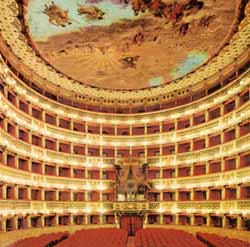 The
Servant Mistress was the first full-scale comic opera and was first
performed in 1731 at the San Bartolomeo
Theater in Naples, the house that San Carlo replaced. It is still played
today and is one of the very few Neapolitan comic operas still in the
standard repertoire. Hundreds were written and almost none survive.
They were done in by Romanticism. Fluff was fun, but by the late 18th
century, it had given way to more serious things such as Revolution,
Heroism, Love, Courage, Valor and Beethoven. Neapolitan comic operas,
also, it is fair to say, suffer somewhat in comparison to the comic
operas of Mozart. It is also fair to say, however, that most things
suffer somewhat in comparison to Mozart. The
Servant Mistress was the first full-scale comic opera and was first
performed in 1731 at the San Bartolomeo
Theater in Naples, the house that San Carlo replaced. It is still played
today and is one of the very few Neapolitan comic operas still in the
standard repertoire. Hundreds were written and almost none survive.
They were done in by Romanticism. Fluff was fun, but by the late 18th
century, it had given way to more serious things such as Revolution,
Heroism, Love, Courage, Valor and Beethoven. Neapolitan comic operas,
also, it is fair to say, suffer somewhat in comparison to the comic
operas of Mozart. It is also fair to say, however, that most things
suffer somewhat in comparison to Mozart.
Recently,
Naples held a months-long revival of the music of Pergolesi, many of
whose works have not been heard since they were first performed. Like
many of his contemporaries, he was a very versatile composer; his best
known composition, one which is still very much part of the standard
orchestral repertoire today is a serious, sacred work: the Stabat
Mater.
Another
great composer of comic opera was Gioacchino Rossini (1792-1868). He was not Neapolitan,
but is intimately connected with the musical history of the city, in
that he took over the role of "house composer" in 1814. It was
the beginning of the move away from Neapolitan composers, but one that
kept San Carlo in the mainstream of European music, at least for a while
longer. Rossini, Vincenzo Bellini and Gaetano
Donizetti, three of the great names in Italian opera in the first
half of the 19th century, were all connected with the
Naples conservatory and San Carlo. Bellini and Donizetti were the
bridge to the new music of Romanticism, while Rossini was, somewhat
anachronistically, the link to the comic operas of the past. He deserved
better than he got.
Rossini's
greatest work, The Barber of Seville, is arguably the best comic
opera ever composed, Mozart notwithstanding. It was performed
for the first time in Rome and not in Naples. That may have been a good
thing, since there was already a very popular work of the same name
by the Neapolitan, Paisiello, whose hooligan fans went to Rome for the
opening of Rossini's work just to make rude noises. They say that even
members of the cast(!) conspired to make the premiere flop. The conspiracy
worked so well that Rossini got discouraged and didn't go to the second
performance; his friends had to hunt him up and tell him it had been
a hit. History, of course, has since consigned Paisiello's work to the
list of operatic also-rans. Rossini didn't take criticism or failure
lightly. His attempt at something a little more serious and in keeping
with the times, William Tell, was not well received and he subsequently
quit writing opera altogether at the age of 37. He lived another thirty
years.
San Carlo
burned to the ground during a performance of one of Rossini's works
in 1816, but was rebuilt in a few months time. It was even more spectacular
than the original. Stendahl wrote that he felt as if he had been "transported
to the palace of some oriental emperor…my eyes were dazzled, my
soul enraptured. There is nothing in the whole of Europe to compare
with it."
By 1850,
a northern Italian composer had appeared on the scene: Giuseppe Verdi.
In spite of the prestige of the Naples theater, the unfavorable conditions
of censorship in the Kingdom of Naples at least partially contributed
to Verdi's decision to take his operas elsewhere, particularly after
Neapolitan censors objected to the regicidal
theme of Un Ballo in Maschera.
Even after the unification of Italy,
when censorship was no longer a problem in Naples, Italy's greatest
composer still regarded Naples and San Carlo as a provincial backwater.
By the
late 19th century, the emphasis in opera in Italy had for political
and economic reasons shifted to the north. San Carlo was late in introducing
the new music of the day, works by Gounod, Bizet, and Wagner, for example.
Neapolitan composers such as Leoncavallo (I Pagliacci) and Alfano
(most famous for having finished Puccini's last work, Turandot
) went elsewhere to live and work. Arturo Toscanini took over the direction
of La Scala in Milan in 1899 and assured that city's supremacy in the
world of opera.
San Carlo
has since continued to go its own peculiar way. In 1901, a young Neapolitan,
Enrico Caruso, sang the role of Nemorino
in Donizetti's L'elisir d'amore. If you go to Caruso's
house in Naples today and see that it has become something of
a shrine, you might well forget that the voice subsequently judged the
greatest operatic tenor in history didn't go over well with the hometown
crowd. He got a bad review in the papers
and vowed never to sing in Naples again. He kept his promise. He went
to America and became one of the 'tired, poor, and huddled masses,
yearning' —to record for RCA.
San Carlo
has recently undergone an overhaul like none in its history. There
are new electrical systems, new public lifts and stage elevators, extensive
fireproof reupholstering and smoke detectors with spray extinguishers.
Thus, new life has been granted to a venerable institution. It is not
common, you know, to find places of culture, such as San Carlo, in continuous
operation for two-and-a-half centuries, anymore than it is common to
find large centers of population, such as Naples, continuously inhabited
for two-and-a-half millennia. Perhaps it is fitting that one is home
to the other.
[More
on San Carlo click here.]
Mergellina;
Sannazzaro, J.; Ravaschieri di Satriano (palazzo)
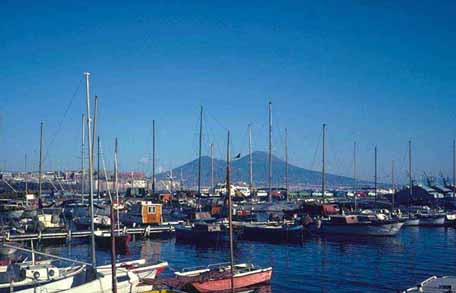 Mergellina is the "other" port in Naples. It is at the
west end of via Caracciolo before the coast starts its long curve
out to Posillipo. Once, Mergellina was a quaint fishing village and
the subject of folksong and myth. Today, it has developed as an important
harbor for pleasure and tourist boats, including those that make runs
to Capri and, indeed, to all of the small secondary
ports in the Campania region, from Bacoli at the extreme top end of
the Bay of Naples to Sapri, many hours to the south. It is, however,
still a working port for fishermen. Mergellina is the "other" port in Naples. It is at the
west end of via Caracciolo before the coast starts its long curve
out to Posillipo. Once, Mergellina was a quaint fishing village and
the subject of folksong and myth. Today, it has developed as an important
harbor for pleasure and tourist boats, including those that make runs
to Capri and, indeed, to all of the small secondary
ports in the Campania region, from Bacoli at the extreme top end of
the Bay of Naples to Sapri, many hours to the south. It is, however,
still a working port for fishermen.
It is not
immediately evident from studying the modern lay-out of the coast between
the Castel dell'Ovo and the harbor of
Mergellina just how isolated Mergellina was from the rest of Naples
through a long history that stretches from the days of the Greeks to
the present. It is true that the city of Naples, itself—the historic center and the immediate surroundings—is
the oldest continuously inhabited center of large population in Europe.
It is, however, equally true that many of the names that one associates
with Naples, such as Mergellina (and even Santa Lucia, much closer in
towards the city than Mergellina) were, until the 1500s, "quaint fishing
villages on the outskirts of Naples" (and I copied that phrase from
an early tour-guide to the area, which so described Santa Lucia, the
area around the Castel dell'Ovo).
Mergellina
is yet another mile to the west along the waterfront. Today, Santa Lucia
and Mergellina are connected by via Caracciolo, a road from the late
1800s. (See here for an item on the urban
renewal of Naples at that time.) If, in the mind's eye, you strip that
road away, you have the modern Public Gardens, the Villa Comunale, which
can still be said to connect the two ends of the long stretch of waterfront
between Santa Lucia and Mergellina. Those gardens were built in the
1780s. Before that park was put in place on reclaimed land, the whole
stretch was a beachfront with water rolling up approximately to where
the road, Riviera di Chiaia, now runs along the inside of the
gardens, 100 yards from the modern seafront.
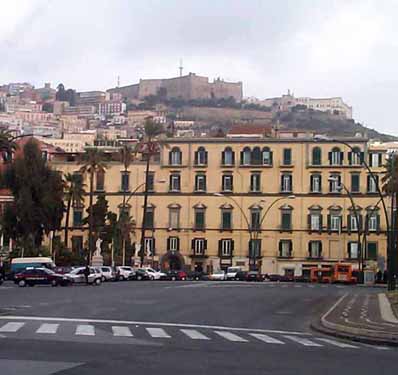 And that road, Riviera di Chiaia, was
laid in the1600s to accommodate the new and exclusive Spanish mansions
that were wending their way ever to the west towards Mergellina.
The first villa—at the east end of the Villa Comunale,
still a mile from Mergellina—was the Palazzo Ravaschieri di
Satriano, a building from 1605 (photo, left). It was prime beachfront
property 400 years ago. (Much later, Goethe mentions the building with
fondness in his Italian Journeys. He speaks of a lovely and enigmatic
woman. He discreetly avoids detailing his notorious womanizing but he
is probably talking about donna Teresa Filangieri, the wife of Filippo
Ravaschieri, owner of the villa at the time. In this photo—on
the hill in the background—Castel Sant'Elmo
is seen on the left and the museum of San
Martino on the right.) Drawings of the area from the 1680s show
a lovely coast-line with a long string of villas starting at this mansion
and a single long road, Riviera di Chiaia, lined with trees. That was
how one got to Mergellina from Naples in the 1600s. And that road, Riviera di Chiaia, was
laid in the1600s to accommodate the new and exclusive Spanish mansions
that were wending their way ever to the west towards Mergellina.
The first villa—at the east end of the Villa Comunale,
still a mile from Mergellina—was the Palazzo Ravaschieri di
Satriano, a building from 1605 (photo, left). It was prime beachfront
property 400 years ago. (Much later, Goethe mentions the building with
fondness in his Italian Journeys. He speaks of a lovely and enigmatic
woman. He discreetly avoids detailing his notorious womanizing but he
is probably talking about donna Teresa Filangieri, the wife of Filippo
Ravaschieri, owner of the villa at the time. In this photo—on
the hill in the background—Castel Sant'Elmo
is seen on the left and the museum of San
Martino on the right.) Drawings of the area from the 1680s show
a lovely coast-line with a long string of villas starting at this mansion
and a single long road, Riviera di Chiaia, lined with trees. That was
how one got to Mergellina from Naples in the 1600s.
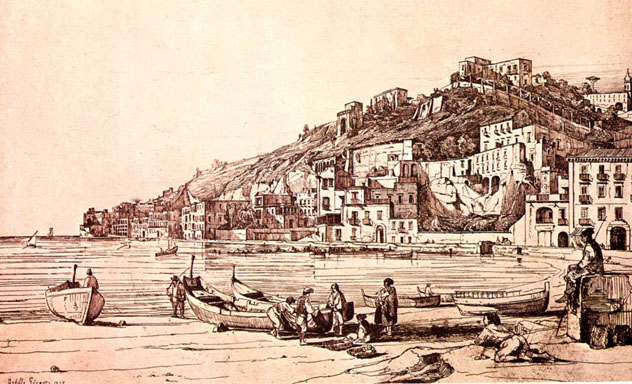 Mergellina, itself—before
that date—was pretty much isolated, except by sea and a single
road leading down from the Posillipo height directly above, a twisting
and steep affair called the Rampe di San Antonio. That road comes out near the
modern Mergellina train station. In the days before trains, all you
saw when you got to the bottom was the Roman tunnel (still in use in
those days) called the "Neapolitan Crypt", in the area called Piedigrotta,
the homonymous church being one of the most famous in Neapolitan tradition.
The modern road, via Posillipo, that leads from Mergellina west
to the very end of the Posillipo hill was not completed until the French
rule of Naples under Murat, although the
Spanish did build a short stretch in that direction to get from Mergellina
to Villa Donn'Anna. Mergellina, itself—before
that date—was pretty much isolated, except by sea and a single
road leading down from the Posillipo height directly above, a twisting
and steep affair called the Rampe di San Antonio. That road comes out near the
modern Mergellina train station. In the days before trains, all you
saw when you got to the bottom was the Roman tunnel (still in use in
those days) called the "Neapolitan Crypt", in the area called Piedigrotta,
the homonymous church being one of the most famous in Neapolitan tradition.
The modern road, via Posillipo, that leads from Mergellina west
to the very end of the Posillipo hill was not completed until the French
rule of Naples under Murat, although the
Spanish did build a short stretch in that direction to get from Mergellina
to Villa Donn'Anna.
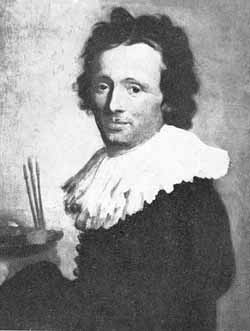 The
Spanish, then, are the ones who started the development that would eventually
incorporate Mergellina into "greater Naples". That development was continued
under the short, but productive, period of the Austrian
vicerealm and then, of course, the Bourbons. The
Spanish, then, are the ones who started the development that would eventually
incorporate Mergellina into "greater Naples". That development was continued
under the short, but productive, period of the Austrian
vicerealm and then, of course, the Bourbons.
Mergellina's
favorite son is, no doubt, the poet Jacopo Sannazaro (1458-1539) (painting,
left), whose verses in Italian are part of the body of literature that
helped form that language in the Middle Ages. His Latin works, primarily
De partu Virginis, though little read today, earned him the nick-name
of "the Christian Virgil". A main square, one block from the harbor,
is named for him.
Filangieri,
Gaetano (1752—1788)
The man who wrote the US Constitution?

It
is certainly an overstatement that the Constitution of the United States
of America was written in a beautiful old building—still
called "the castle"—in Vico Equense, a small town on the
Bay of Naples about halfway out the Sorrentine peninsula, but that's
what citizens of that hamlet delight in telling visitors. Viewed charitably,
it's a good story—a very human one with just that kernel
of historical fact that piques one's interest. It also provides a small
introduction to the person of Gaetano Filangieri, a leading figure of
the Neapolitan Enlightenment, a philosophical movement that thrived
in the mid-and late 18th century.
Filangieri
was born in Naples in 1752. He gained early favor at the court of the
Bourbon monarch, Charles III, King of Naples,
by virtue of his Political Reflections, in which he defended
the king's enlightened reforms of the legal system. He is best remembered
today, however, for his La Scienza della legislazione (The Science
of Legislation) a work he started in 1780 and planned as seven volumes
but which remained unfinished in the middle of the fifth volume upon
his death in 1788.
The
Science of Legislation was, in short, a recipe for creating a just
society based on reason. It ranged from rules on how laws should
be formulated to economics to education and societal ethics. This remarkable
work was an outgrowth of the French enlightenment and was inspired by
the principle that reason should be at the core of a just legal system,
and that the measure of the just society was how well it dealt with
the social and economic realities of that society. It pinpointed the
societal split between the landed few who had much and the landless
many who had nothing—a potentially ruinous situation for modern
nations, which had to face increasing population, inefficient agricultural
output and the beginnings of industry.
Filangieri
may not have been the John the Baptist of class warfare that later Marxists
like to claim, but he was a formidable advocate of reform, calling for
a large class of small property owners, universal public education and
equality before the law. He wanted unlimited free trade and the abolition
of medieval institutions, which impeded production and national
well-being. He called for freedom of the press and toleration in juridical
and social matters, ideas that would later mark the age of post-absolutist
Europe. These ideas certainly had their philosophical origin in the
French Enlightenment but they remained in that lofty arena of philosophical
debate until Filangieri wrote down the specifics—how they
laws themselves would actually look on paper. The Science of
Legislation was a masterpiece of the Italian Enlightenment—and
in 1784 also put on the Index, the Roman Catholic Church's list
of banned books.
The
Science of Legislation enjoyed an immediate success and was translated
into other European languages almost immediately. Though the tone of
the entire work was one of reasoned reform and not violent revolution,
it was on the must-read list of the Jacobins as they prepared the French
Revolution of 1789; also, it was an inspiration to the later Neapolitan Revolution of 1799.
Filangieri's
view of events in the New World, specifically, the American Revolution,
underwent some interesting changes. Like many Europeans, he saw America
from a colonizer's point of view. In The Science of Legislation he
frequently refers to the entire western hemisphere—all
of the Americas—as "Europe's farm". His main concern for
social equality and justice in the Americas seems to have been a pragmatic
one; this is, if Europe abused her colonies in the New World, they might
rebel, fall away and become independent, depriving Europe of a great
resource. Thus, good government was good for everyone—fair
to the governed and profitable to those who govern.
He expressed
those views in 1780 when the first part of The Science of Legislation
was published and General Washington's forces had not yet spent their
rough winter at Valley Forge. Yet, one year later, the American revolution
was over and Filangieri—like many other children of the French
Enlightenment—fell under the spell of the "American myth,"
a place where "Life, Liberty and the Pursuit of Happiness" had just
swept the day. The French historian, J.J. Godechot, has written:
| The
American revolution had immense repercussions in Europe. First
of all, it gave to Europeans the impression that they were living
in an age that was on the verge of prodigious change. They
saw that the philosophical destinies they had been discussing
were not utopian, but might even be fulfilled immediately. That
revolution created for Europe the 'American Myth', the image of
a new society close to the one described by Rousseau.
[J.J.
Godechot, Les révolutions (1770-1799), Paris,
1963. Cited in Andreatta, below. English translation, here,
is mine.]
|
Filangieri
initiated an exchange of letters with Benjamin Franklin, sending him
a copy of the finished portions of The Science of Legislation,
at which point Franklin ordered copies of the remaining volumes as they
would be published. Filangieri also mentioned to Franklin the idea of
emigrating to the new nation and, specifically, to that enlightened
center of the new nation, Philadelphia. From his letter of December
2, 1782, to Franklin:
| Even
as a child, my eyes were drawn to Philadelphia. I have become
so used to viewing it as the only place where I might be happy,
that I can no longer get that idea out of my head. ... But how
can I leave my country? ... Might not my own works on the law
lead you to consider inviting me to help draw up the new legal
code you are preparing for the United Provinces of America? ...
Once I got to America, who could ever convince me to return to
Europe! How could I ever then leave that haven of virtue, that
land of heroes and city of brothers, all to return to a nation
corrupted by vice and degraded by servitude? ... Having known
a society of citizens, could I ever again desire the company of
courtesans and slaves?
[Cited
in both Andreatta and Pace, below. English translation, here,
is mine.]
|
The extent
of the exchange of letters between Filangieri and Franklin is documented
in Antonio Pace's authoritative Benjamin Franklin and Italy (see
bibliography, below.) Because some of that correspondence has not survived,
it is impossible to be precise about all the details. Yet, in the words
of Pace, "...[what has survived] allows us to piece together almost
completely... [the nature of the correspondence]...".
This
1805 engraving of Franklin is by J. Thompson,
after a painting by J.A. Duplessis.
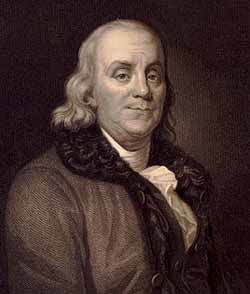 Filangieri
and Franklin exchanged letters from 1782 to 1787. On the one hand, Franklin
was the American Rousseau—scientist, philosopher, elder statesman,
charmer and absolute toast of Paris during his term as US ambassador
to France. On the other hand, Filangieri was the young, enthusiastic
social reformer, eager to flaunt his considerable knowledge and, as
well, just as eager to reap praise from the American, whom he quite
obviously worshipped. Filangieri
and Franklin exchanged letters from 1782 to 1787. On the one hand, Franklin
was the American Rousseau—scientist, philosopher, elder statesman,
charmer and absolute toast of Paris during his term as US ambassador
to France. On the other hand, Filangieri was the young, enthusiastic
social reformer, eager to flaunt his considerable knowledge and, as
well, just as eager to reap praise from the American, whom he quite
obviously worshipped.
After an
exchange of gifts (including copies of The Science of Legislation
for Franklin) and after Filangieri had semi-invited himself to America,
Franklin cautiously discouraged Filangieri from jumping into such a
risky venture without really knowing what he might be getting into.
To that end, Franklin suggested that the young man jockey for position
in whatever diplomatic or economic relations might be about to
open up between the new United States of America and Filangieri's Kingdom
of Naples. Filangieri saw the wisdom of that suggestion and agreed to
look into it. Franklin then sent Filangieri some French translations
of the various constitutions of the individual states in the US. Filangieri
thanked him, commenting that they seemed too restrictive in terms of
allowing the will of the people to flourish!
Filangieri
died of tuberculosis in 1788 at the ridiculously young age of 35. That
was, however, long enough to see the inadequate Articles of Confederation
fail to regulate the new "haven of virtue and land of heroes". And it
was long enough to see his pen-pal, Benjamin Franklin—in
spite of great age and infirmity—head the Pennsylvania
delegation to the hopeful Constitutional Convention of 1787. Franklin
sent Filangieri a copy of a draft of the new Constitution, appending
the note, "...it may be a matter of some curiosity to you, to know what
is doing in this part of the world respecting legislation." It is not
clear whether Filangieri received and read that before his death. After
Filangieri died, his wife sent Franklin a poignant note, relating that
her husband had left her nothing but the "memory of his virtues". Here,
again, we don't know that Franklin got the note before he, himself,
passed away.
Filangieri
did not see the adoption of the Constitution of the United States in
1789. He also missed the cataclysmic French Revolution of
the same year as well as the brief excursion into republicanism
in his own Kingdom of Naples in 1799; thus, whatever his opinions might
or might not have been on these events is speculation. Missing the short-lived
republican overthrow of the Bourbons in 1799 was probably just as well.
He most certainly would have joined the Republic and wound up on the
gallows. More than one Bourbon judge at the royalist trials of the Neapolitan
rebels lamented that Filangieri was no longer around to get what he
deserved.
Well, he
does deserve his reputation as an enlightened reformer.
Did he really have anything to do with the substance of the US Constitution?
I don't know—and that puts me in pretty good company. It
is true that Franklin ordered a lot of copies of everything that Filangieri
wrote, so he was obviously doing something with them besides reading
them, himself—perhaps handing them around to his friends
as they beat themselves up over how to formulate a workable document
that would govern a new nation. (There was no integral English translation
of the Science of Legislation until 1806, but bits and pieces
of it are bound to have been in circulation well before that.) So, if
my friends in Vico Equense want to believe that Gaetano Filangieri burned
the midnight oil in "the castle" turning out drafts of the US Constitution
to pass on to Franklin who then informed the Convention—then,
who am I meddle with a good story?
Worth
reading:
Andreatta,
Alberto. Le Americhe di Gaetano Filangieri. Edizioni Scientifiche
Italiane. Naples. 1995.
Pace,
Antonio. Benjamin Franklin and Italy. Philadelphia, 1958.
San
Gregorio Armeno (1)
via
S. Gregorio Armeno
 The
church/monastery of San Gregorio Armeno is in the heart of the historic
center of Naples and has given its name to the street on which it
is situated. In common parlance, that street is referred to as the street
of the figurari, in reference to those who craft the popular
figures and sets used in the typical Neapolitan Christmas manger scene,
the presepe. The street is marked by
the tower of the church belfry that actually spans the street, itself
(see photo). It is from the 1700s and was built onto an earlier walkway
above the street. The
church/monastery of San Gregorio Armeno is in the heart of the historic
center of Naples and has given its name to the street on which it
is situated. In common parlance, that street is referred to as the street
of the figurari, in reference to those who craft the popular
figures and sets used in the typical Neapolitan Christmas manger scene,
the presepe. The street is marked by
the tower of the church belfry that actually spans the street, itself
(see photo). It is from the 1700s and was built onto an earlier walkway
above the street.
The church
was founded shortly after the iconoclast decrees of the eighth century
caused a number of religious orders to flee the Byzantine empire and
seek refuge elsewhere. Those dedicated to Gregory, bishop of Armenia
(257-332), founded their place of worship in Naples on the site of an
older Roman temple of Ceres. In 1025 it was joined with two other
adjacent chapels into a single complex as a Benedectine monastic order.
[For a separate item on early Christian churches in Naples, click
here.]
The
courtyard of San Gregorio Armeno
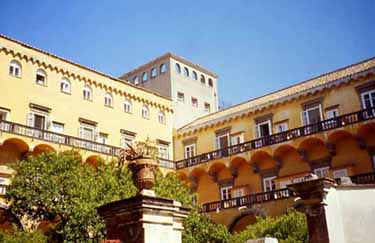
The monastery
still functions as such, retaining its high walls and maintaining a
spectacular inner courtyard characterized by a central fountain
with a sculpture of Christ and the Samaritan by Matteo
Bottigliero from 1733.
Jesuits
in Naples
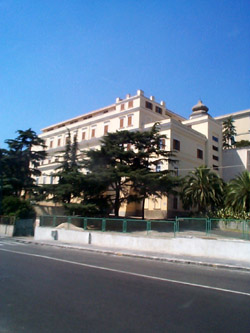 I
have read any number of times that the "Jesuits were expelled from Naples
in 1773" and have even referred to that episode in some of the items
I write. It recently occurred to me that I knew nothing about the affair.
So, with apologies to any Jesuit historians who may be reading this…(please
don't hunt me down to "correct" me). I
have read any number of times that the "Jesuits were expelled from Naples
in 1773" and have even referred to that episode in some of the items
I write. It recently occurred to me that I knew nothing about the affair.
So, with apologies to any Jesuit historians who may be reading this…(please
don't hunt me down to "correct" me).
"Jesuits"
are, properly termed, members of "The Society of Jesus"; the name
"Jesuit" was apparently coined by the Protestant, Calvin, although it
is commonly used even today by Roman Catholics. The Society was founded
by a Spanish soldier, Ignatius of Loyola in 1539. He originally called
his order "The Company of Jesus," an indicator, no doubt, of the militant,
aggressive spirit that imbued the organization. Although the Company
was not founded expressly to combat Protestantism (Martin Luther put
his 95 Theses up on the castle church door in Wittenberg in 1517), it
was in the forefront of the movement of Catholic revival commonly called
the "Counter-Reformation," the official origins of which were at the
Council of Trent in 1545. The Jesuits were (and are) extremely active
in missionary activity throughout the word and are known, as well, for
their charitable work and emphasis on education.
From the
very beginning, the order of Jesuits was marked by—I think it
is fair to say—a supranational sense of mission. Their ultimate
religious allegiance was, of course, to the Pope, but they also swore
allegiance to the head of their order, the General, an office that became
so strong in the course of the centuries that its holder was often termed—unofficially,
of course—"The Black Pope". That kind of situation breeds a sense
of, at least, semi-autonomy—guaranteed not to sit well with an
earthly monarch.
In a way,
obedience to God before King made some sense in the Middle Ages, especially
the early Middle Ages, before there were European nation states. There
certainly was a time when you were, first of all, a Christian before
you were Spanish or French or German. Yet, by the 1500s—and certainly
the 1600s—that sense of overarching obedience to the princes of
the Church over the princes of the Earth was an anachronism and was
one of the factors that contributed to the conflict between the Jesuits
and the rulers of Europe, a conflict that led to the eventual suppression
of the order.
By the
mid-1700s, Jesuit activities in the mission field, in commerce, trade
and banking (in order to have money for their missions)—their
behind-the-scene intrigues (according to their critics)—created
such ill feeling between them and, primarily, the Bourbon monarchs of
Europe (France, Naples, Spain) that there was wholesale call from those
nations to the Pope to abolish the order.
Some nations
didn't wait. Portugal took the matter into its own hands in 1760 and
kicked the Jesuits out of the country. France did the same in 1762.
Spain expelled the Jesuits in 1767, marching 6000 of them to the coast
and expelling them to the Papal States. It is clear that the general
spirit of the times also had something to do with all this. The Humanism
of the French Enlightenment was bound to be on a collision course with
a dogmatic religious order. France and the Kingdom of Naples were home
to many influential philosophers who were natural enemies of such soldiers
of the faith as the Jesuits.
Clement
XIII, a friend of the Jesuits, was elected Pope in 1758. When he died
in February 1769, a conclave to elect his successor assembled in Rome.
Those charged with electing the new Pope were beset by a powerful coalition
of anti-Jesuits from Spain, France and Naples whose single purpose was
to get someone elected who would abolish the Jesuit order. Representatives
from those nations were—at least, so they said—prepared
to wage economic, military, and even religious war (that is, they threatened
schism) against the Papal States unless they got what they wanted. Such
intrigues are beyond me, but, interestingly, the choice for Pope went
to one who had been educated by the Jesuits—Cardinal Ganganelli,
who took the papal name of Clement XIV.
Medallion
with a likeness of Clement XIV
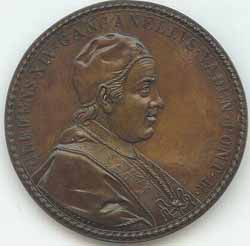 The
Pope was reluctant to suppress the Jesuits. He still had some political
backing from the Hapsburgs in Austria, who, obviously, were against
anything the Bourbons were for. That support faded when empress Maria-Theresa
married off one of her children, Marie Antoinette, to the Bourbon king
of France. Part of the agreement was that Habsburg royalty stop defending
the nefarious Jesuits. The
Pope was reluctant to suppress the Jesuits. He still had some political
backing from the Hapsburgs in Austria, who, obviously, were against
anything the Bourbons were for. That support faded when empress Maria-Theresa
married off one of her children, Marie Antoinette, to the Bourbon king
of France. Part of the agreement was that Habsburg royalty stop defending
the nefarious Jesuits.
In any
case, the Pope caved in to the anti-Jesuits and issued a decree of suppression,
the Dominus ac Redemptor, in June 1773. It wasn't a particularly
strong edict. The general line was that orders had been abolished in
the past and since the presence of the Jesuits seemed to be such a source
of conflict, it was better for the peace of the church if the society
was abolished. The strongest language was probably,
| …the
Society from its earliest days bore the germs of dissensions and
jealousies which tore its own members asunder, led them to rise
against other religious orders, against the secular clergy and
the universities, nay even against the sovereigns who had received
them in their states… |
Although
some regimes in northern and eastern Europe refused to implement the
ban, elsewhere the results were immediate. In Naples, Jesuit property
was seized, and their churches closed. (In some cases, they were given
to other orders (the Church of San Ferdinando,
for example), and the Jesuit brothers themselves were expelled from
the Kingdom. Similar to the Spanish experience, Neapolitan Jesuits were
marched north to the border with the Papal States and expelled under
threat of death if they returned.
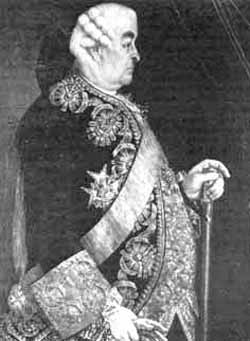 A
common thread in the expulsion of the Jesuits in Spain and then Naples
is that Charles III of Bourbon was the
King of Spain when the Jesuits were forced to leave that nation, and
his son, Ferdinand IV was the king of Naples when the same thing happened
there. (Charles, of course, had ruled Naples before abdicating to return
to Spain.) Influential in the lives of both monarchs was Bernardo Tanucci
(painting, left), the astute Foreign Minister under Charles III and
then the regent of Charles' child-king son. Tanucci was one of the prime
movers among anti-Jesuits in Naples. His influence faded after that,
and he was edged out of the picture by Ferdinand's ambitious wife, Caroline. A
common thread in the expulsion of the Jesuits in Spain and then Naples
is that Charles III of Bourbon was the
King of Spain when the Jesuits were forced to leave that nation, and
his son, Ferdinand IV was the king of Naples when the same thing happened
there. (Charles, of course, had ruled Naples before abdicating to return
to Spain.) Influential in the lives of both monarchs was Bernardo Tanucci
(painting, left), the astute Foreign Minister under Charles III and
then the regent of Charles' child-king son. Tanucci was one of the prime
movers among anti-Jesuits in Naples. His influence faded after that,
and he was edged out of the picture by Ferdinand's ambitious wife, Caroline.
The Jesuits
didn't return to the Kingdom of Naples until 1827—well after the
initial wave of anti-Jesuit feeling and well after the ultimate anti-cleric,
Napoleon (acting through his puppet-king, Murat),
had caused all monastic orders in Naples to be abolished. The Restoration
of 1815 had its way and the order eventually came back to Naples. In
1860, they were again dispersed as part of the general wave of anti-clericalism
in the new united Italy. In Naples, the Jesuits have again had premises
since 1898, and they run a respected university, the "Pontificia
Facoltà Teologica dell'Italia Meridionale, San Luigi," located
on via Petrarca in the Posillipo section of the city (photo,
top).
Gestures, hand (2)
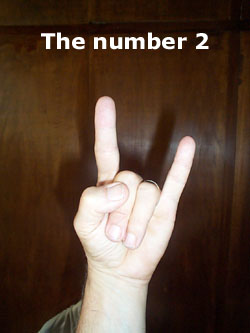 I
have a couple of young Neapolitan friends who are fans of American professional
sports, especially basketball and football. They enjoy NBA games on
TV and are fans of the local Naples pro basketball team. At the appropriate
time of the year, they turn out to practice with a local semi-pro Naples
football team sponsored by a local clothing store called "Original Marines".
That's the real name of the store, and that's the name the team have
emblazoned on their football jerseys when they play. It's strange to
see the bunch of them all decked out in football helmets, shoulder pads
and assorted body armor running around a field where people normally
play soccer. They endure a lot of good-natured ribbing from passers-by,
but it's all in fun. I
have a couple of young Neapolitan friends who are fans of American professional
sports, especially basketball and football. They enjoy NBA games on
TV and are fans of the local Naples pro basketball team. At the appropriate
time of the year, they turn out to practice with a local semi-pro Naples
football team sponsored by a local clothing store called "Original Marines".
That's the real name of the store, and that's the name the team have
emblazoned on their football jerseys when they play. It's strange to
see the bunch of them all decked out in football helmets, shoulder pads
and assorted body armor running around a field where people normally
play soccer. They endure a lot of good-natured ribbing from passers-by,
but it's all in fun.
One of
the things that most intrigues them about American sports is the way
US referees signal numbers with their fingers. I must say that it intrigues
me, as well. Times have changed. Number "one" (the raised index finger)
has stayed the same, but we used to make "two" with a simple "V" of
index and middle finger. I see referees now making "two" with the raised
index and little finger. In Naples and most anywhere in the Latin world,
that particular configuration of fingers is exclusively the sign of
the cuckold --the betrayed husband-- and the rudest hand gesture you
can make. It is enough to start fights --even, in certain circumstances,
fights to the death. It amuses my friends no end to see an American
referee giving 80,000 fans in the stadium—and who knows how many
more at home!—that sign from the middle of the field when it's
second down.
The number
3 is tricky. It was always hard, anyway. You had to use your thumb to
hold down the pinkie way over on the other side of your palm in order
for the three fingers in the middle to pop up. The new American “3”
is made by thumbing down the index finder and extending the middle,
ring, and little fingers. Some people find that an improvement, I know,
but these are the same people who have trouble with the Vulcan sign
for “Live Long and Prosper”. Four and five were, and remain,
easy.
Neapolitan
refs are torn between the two systems, I notice. They generally make
the sign for "one"—say, on first down—with the index finger,
although that number is usually signed elsewhere—maybe in a bar
to order one of anything—by a thumbs-up sign. "Two" is—again,
in a restaurant—a thumb and index finger, kind of like shooting
off an imaginary pistol toward the ceiling. Naples football refs are
unsure of this one and there is some talk of an ecumenical conference
to decide the issue; they use either the thumb/index finger version
or the "V" sign, but under no circumstances the new and improved cuckold
sign. "Three" in a restaurant and on the field is the extended thumb
and "V" sign—none of this prestidigitatious contortionism of having
to grapple with your own pinkie. Very few of my students at the university
of Naples can easily make either one of the American signs for 3 without
giggling as they struggle with it. Four and five are the same in both
Naples and the US: thumb down and all others up for "4" and everything
up for "5".
The only
trouble I ever had with "5" was in Greece, when I was made aware of
the fact that showing someone your outstretched palm in the manner we
would use to show "5" is the same as "giving the finger" to someone
in the US. I don't think they play American football in Greece.
Croce,
Benedetto (3), Filomarino (Palazzo)
 Palazzo Filomarino della Rocca is most recently
well-known for having been the residence of the great Neapolitan historian
and philosopher, Benedetto Croce. The original structure was built
in the 1300s and was rebuilt and enlarged in the first decade of the
1500s. Subsequent modifications were added by the renowned architect
Ferdinando Sanfelice in the 1700s when the building passed into the
hands of Tommaso Filomarino della Rocca. He was responsible for the
addition of a fine library, as well, keeping with the intellectual
tradition of the premises, which had in the past hosted no less a philosopher
than Giovan Battista Vico. That tradition
still survives, as the building currently houses the Italian Institute
for Historical Studies founded by Croce. The building is on a long street
popularly known as "Spaccanapoli" (Naples-Splitter) in the historic
center of the city (see number 5 on the map of the historic center of Naples.). The section of
the street where the building stands is, today, named via Benedetto
Croce. Palazzo Filomarino della Rocca is most recently
well-known for having been the residence of the great Neapolitan historian
and philosopher, Benedetto Croce. The original structure was built
in the 1300s and was rebuilt and enlarged in the first decade of the
1500s. Subsequent modifications were added by the renowned architect
Ferdinando Sanfelice in the 1700s when the building passed into the
hands of Tommaso Filomarino della Rocca. He was responsible for the
addition of a fine library, as well, keeping with the intellectual
tradition of the premises, which had in the past hosted no less a philosopher
than Giovan Battista Vico. That tradition
still survives, as the building currently houses the Italian Institute
for Historical Studies founded by Croce. The building is on a long street
popularly known as "Spaccanapoli" (Naples-Splitter) in the historic
center of the city (see number 5 on the map of the historic center of Naples.). The section of
the street where the building stands is, today, named via Benedetto
Croce.
(Also see
here for a wartime episode in the life
of Croce.)
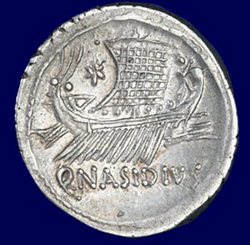 The
Imperial Port of Baia The
Imperial Port of Baia
Not
long ago, a piece of an oar was dredged up from the mud of Lake Lucrino,
the small body of water near Baia in the bay of Naples. Well, you
say, the Mediterranean is brimming with such bits of antiquity. What's
so special about this one? This one, it seems, was from a Roman ship,
a fighting vessel that was part of a fleet built nearby and that trained
here for its subsequent role in one of the most important naval engagements
in history. There are three such bodies of water in the area that
were crucial in Roman naval history and subsequently in the rise of
the Roman Empire: namely, Lake Lucrino, Lake Averno and the harbor
of Miseno.
Roman history
in the first century before Christ was marked by civil warand unrest.
The tumult came to a head with the assassination of Julius Caesar in
44 BC, an event that set the stage for the struggle to determine who
would rule Rome. That struggle was between Octavian, a great-nephew
of Julius Caesar, and Marc Antony. The latter was in league with Egypt
(and very in league with Cleopatra!), so the struggle could be said
to be between the forces of Rome and those of Egypt. The struggle was
decided in 31 BC at the Battle of Actium, a small dot on the Balkan
coast in northern Greece opposite the heel of the boot of Italy.
To fight
effectively at sea, the Romans had to change their traditional thinking.
For centuries, during the Punic Wars, the Macedonian Wars and endless
adventures against piracy in the Mediterranean, Rome had been content
not even to have her own real navy. Instead, she relied on using --renting--
small squadrons of vessels from her maritime allies, such as the Greek
city-states on the Italian mainland and on Sicily. It was a policy that
had worked but one that had more than once almost proved disastrous,
such as when Sextus attempted to cut off all supply routes in 40 BC,
almost succeeding in blockading Rome into submission.
Octavian,
thus, chose to build a fleet from scratch, and he chose his very able
deputy, Agrippa, to build and command it. Four-hundred ships were built
from the wooded areas near Naples and they trained on Lake Lucrino, a few miles north of Naples. (The lake
at the time of the Romans was much larger than the pond you see today.
The violent seismic activity in the 16th century that formed the hill
of Montenuovo right next to it also emptied most of the water.) Agrippa
joined Lake Lucrino to the adjacent Lake Averno and to the gulf of Cuma
by canals in order to form a single large naval base, portus Iulius.
(A chariot tunnel from Averno to Cuma was built at the same time and
has partially survived the ravages of time.)
The Roman
vessels were somewhat smaller than those of Marc Antony. The
Roman fleet that trained at Lucrino and Averno was made up of small,
fast triremes (sailing ships with three banks of oarsmen) as well as
"fives" and "sevens" (here, the number refers to the number of rowers
on each oar). The Romans specialized in speeding into close quarters
and boarding by grapnel to let their superb infantry swarm onto enemy
vessels. Antony's fleet, on the other hand, was the last great one in
history built along lines pioneered by the Greeks. Some of the ships
were monsters, virtual sea-going cities with boarding towers, artillery
and large infantry forces on board. They were propelled through the
water by sail and as many as ten rowers on a single oar.
The two
fleets, each of 400-500 vessels, met off of Actium. The Roman fleet
had been in battle a few years earlier. Marc Antony's fleet was green.
The battle, itself, was somewhat of an anticlimax. The Romans succeeded
in bottling up the Egyptians along the coast and picking them off little
by little until Queen Cleopatra decided to make a run for it. She got
away --and her fleet commander and lover, Marc Antony, sailed right
after her, deserting his men and ships! The disheartened Egyptian fleet
surrendered to the forces of Octavian, effectively ending the dispute
about who was going to rule Rome. Antony and Cleopatra did the Liebestod
thing, Octavian changed his name to Caesar Augustus, and all was right
with the world.
The third
important small body of water in the area (after Lucrino and Averno)
was Miseno, the natural harbor sheltered
by Cape Miseno near Cuma. Misenum actually referred to the pair of harbors
behind the cape: inner and outer, to the west and east, respectively.
They had been used for centuries by the Greek city-state of Cuma just
beyond the gulf. Caesar Augustus formed his first imperial fleet shortly
after the Battle of Actium. He had two main bases built in Italy: one
at Ravenna at the mouth of the Po river, and the other at Miseno. To
make Misenum suitable for its new role as an Imperial home port, the
Romans built new breakwaters and a freshwater reservoir of unparalleled
size. The outer harbor served the active vessels of the Roman navy and
provided room for training exercises, while its inner counterpart (to
which it was connected by a canal crossed by a wooden bridge) was designed
for the reserve fleet and for repairs, and as a refuge from storms.
The complex remained connected by canal and tunnel with Averno and Lucrino.
Because
of its location, Misenum controlled the entire Italian west coast, the
islands and the Straits of Messina. The Misenum fleet had a number of
secondary ports along the Tyrrhenian coast, probably at Ostia, Centumcellai
(modern Civitavecchia) and Calaris (Cagliari) in Sardinia. Eventually,
the Roman Empire would extend its Imperial fleets, with 'home ports'
at Alexandria, in Syria and Britain, as well as a river fleet in Germany.
The Misenum fleet, however, being one of the two Imperial fleets of
the Italian homeland, is referred to—as is the Ravenna
fleet—in Roman records as classes praetoriae, a
prestigious term, indeed, putting them on a par with the Imperial Guard,
the Praetorians. The importance of the Misenum fleet waned with the
integrity of the Roman Empire, itself. The fleet survived the periods
of unrest in the third century and was reorganized, but later proved
ineffective in keeping Constantine's ships from seizing Italian ports
in the struggles that led to the ultimate division of the Roman Empire
into two parts, east and west.
Gerolamini
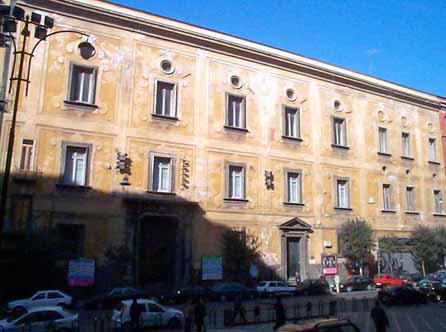 Directly across from the Cathedral of Naples on via
Duomo is the large complex of the church and monastery of the Girolamini.
It is on the site of an earlier building, Palazzo Seripando,
which was donated to the disciples of San Filippo Neri in 1586. The
original building was demolished and construction started on the new
complex in 1592 on plans by the architect Giovanni Antonio Dosio. The
church is in the style of the Florentine Renaissance: a Latin cross
with three naves and lateral chapels. The entrance is on Piazzetta
Gerolamini around the corner on via dei Tribunali. Directly across from the Cathedral of Naples on via
Duomo is the large complex of the church and monastery of the Girolamini.
It is on the site of an earlier building, Palazzo Seripando,
which was donated to the disciples of San Filippo Neri in 1586. The
original building was demolished and construction started on the new
complex in 1592 on plans by the architect Giovanni Antonio Dosio. The
church is in the style of the Florentine Renaissance: a Latin cross
with three naves and lateral chapels. The entrance is on Piazzetta
Gerolamini around the corner on via dei Tribunali.
Members
of the order were called Girolamini because the premises were
the first site of the church of San Girolamo della Carità.
Much of the premises, including the impressive library and archives,
has been recently restored. Like many buildings from the period of the
Spanish viceroyship (1500-1700), this one, too, was “touched up”
by the great architects of the later Bourbon
period. In this case it was Ferdinando Fuga who redid the façade
in 1780.
Near the
entrance is the building where the philosopher Giambattista Vico lived for 20 years and that until
the middle of the 1700s, housed the Conservatory of the Poor of Jesus
Christ, an orphanage that trained children to be church musicians. It
is in Naples that this use of ‘Conservatory’ (a place where children
were ‘conserved’— hence, an orphanage) was, thus,
extended to mean a music school. The renovated premises house an impressive
art gallery and are the site of a number of exhibits throughout the
year.
Acton—
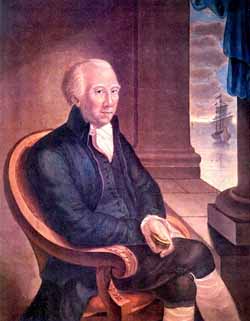 If
you read a little about Naples—or just walk around it a bit—sooner
or later you come across the name "Acton". Indeed, it is difficult to
keep your Actons straight. This, then, may help. If
you read a little about Naples—or just walk around it a bit—sooner
or later you come across the name "Acton". Indeed, it is difficult to
keep your Actons straight. This, then, may help.
The most
recent Acton relevant to Naples is Sir Harold Mario Mitchell Acton (1904-1994),
author of an authoritative 2-volume history of the kingdom of Naples
under the Bourbons, The Bourbons of Naples (1957) and The
Last Bourbons of Naples (1961). Harold Acton was one of the bright,
young intellectual lights of British university life of the 1920s and
such a supporter of new poetry that he once read Eliot's The Wasteland
through a megaphone at a garden party at Oxford. Acton was apparently
the inspiration behind Evelyn Waugh's fictional character, Anthony
Blanche, in Brideshead Revisited, who pulled the same stunt in
the novel.
Harold
Acton was born at Villa la Pietra, his family's estate near Florence.
He passed away there, as well, bequeathing his $500,000,000 estate,
including his Italian Renaissance villa and art collections to New York
University. A bizarre episode connected with the bequeathal is that
it was contested by five Italians who claim they are entitled to the
estate because their mother was the illegitimate daughter of Acton's
father, Arthur Mario Acton, making her Harold Acton's half-sister, whose
children would be entitled to the estate since Harold died without heirs.
The bizarre part is that earlier this year, an Italian court gave permission
to exhume Harold's earthly remains for DNA testing: I don't know if
that has been done.
The Acton
name in Naples goes back to Sir John Francis Edward Acton (1736-1811)
(anonymous portrait, above), an Englishman who served with such valor
in the service of the joint Spanish and Tuscan naval expedition against
Algiers in 1775 that he came to the attention of Queen Caroline of Naples
who acquired his services to reorganize the Neapolitan navy. He became
the commander of the navy, then the minister of finance, and then the
prime minister. He was also—according to most sources—the
Queen's lover. On the occasions of both flights of the royal family
to Sicily, first to escape the Neapolitan Republicans in 1799 and then the French
invasion of 1806, Acton accompanied them and returned with them.
Most notably, John Acton was responsible for the construction of the
new Royal Naval Shipyards at Castellammare di Stabia.
Vincenzo Cuoco, in his Saggio Storico sulla Rivoluzione
di Napoli, remarks that Acton was an astute judge of character and
the first one on the scene to really understand something that later
became evident to all—in Naples, the king, Ferdinand, was an absolute
dud; Queen Caroline ran the show. As an ally of the English and avowed
enemy of the new French Republic, he is seen as at least partially responsible
for provoking the French invasion of southern Italy that helped establish
the Neapolitan—or Parthenopean—Republic in 1799.
John Acton's
brother was General Joseph Edward Acton, who was also in the service
of the kingdom of Naples. Presumably, Joseph had children. I know nothing
about them, except that they will confuse any attempt at genealogical
straight-thinking on my part. Anyway, John got a papal dispensation
to marry his brother's 13-year-old (!) daughter. They had two children,
one of whom was Charles Januarius Edward (1803-1847), who eventually
became a cardinal in the Roman Catholic church and protector of the
English College at Rome. John's other son was Richard Acton, whose only
son was John Emerich Edward Dalberg Acton (1834-1902), the historian
and one of the great intellects of Victorian England. He is remembered
for writing The History of Freedom in Antiquity and The History
of Freedom in Christianity and for being the prime mover behind
the great Cambridge Modern History.
So, you
say (if you are still awake), all this is how the street, via Acton—the
road along the main port of Naples in front of the Maschio Angioino;got its name, right? No, that street
is named for another Acton—Ferdinand. Oh, there are two of them.
The first is Sir Ferdinando Acton (1801-1837), the gentleman who, in
1826, acquired the property for—and had built on that property—the
magnificent Villa Pignatelli, a building that still graces
the Riviera di Chiaia. I am not sure where Ferdinand came from—presumably
from another Acton, possibly John's brother, Charles (above).
Via
Acton, however, is named for the other Ferdinand Acton (1832-1891),
an officer in the Neapolitan navy and then, following the unification
of Italy, an admiral in the Italian navy and then Minister of the Navy.
Sources tell me that his father's name was Charles, so that might make
him the grandson or great-grandson of Charles, John's brother.
Or maybe
not.
Pozzuoli
The
Rione Terra, the old part of Pozzuoli
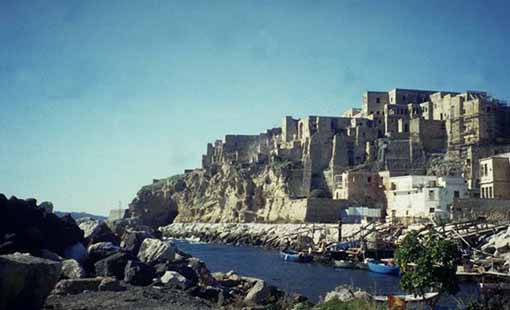 If
you are a city aiming at immortality, you could do worse than preserve
yourself in volcanic ash. That is, after all, what gave Pompeii and
Herculaneum their eerie foreverness— and gives us the pleasure
of being able to stroll their ancient streets, peeping into living rooms. If
you are a city aiming at immortality, you could do worse than preserve
yourself in volcanic ash. That is, after all, what gave Pompeii and
Herculaneum their eerie foreverness— and gives us the pleasure
of being able to stroll their ancient streets, peeping into living rooms.
Quite another
case is nearby Pozzuoli, just north of Naples. It is so worn down by
2,500 years, so overlaid with bits and pieces of successive civilizations,
that it is virtually impossible for the casual observer to recognize
it as the important city of the ancient world that it was. Excavations
are now going on and, ultimately, plans call for a museum, guided tours,
and the wherewithal to help you appreciate ancient Pozzuoli, just as
you do its Vesuvian cousins to the south. The project entails excavating
and restoring a 200 x 240 meter area of the Rione Terra, the
old city. Indeed an ambitious project.
The city
was founded in the middle of the sixth century b.c. by settlers from
Greece. Like those who founded nearby Cuma and
Parthenope (Naples) in those days along the same coast, these settlers
also chose a strategic promontory for their city. They named their new
home Dicaearchia ("Just Government"), a poetic name, presumably
making a point about the place they had fled, the island of Samos, ruled
by the tyrant Polycrates. As yet, archaeology has uncovered only the
most fragmentary physical evidence of this ancient Greek city. Dicaearchia
probably went into decline as its powerful neighbour, Cuma, became more
and more powerful. This idea is supported by the Greek historian Strabo,
who, in the first century before Christ, referred to the city (renamed
Putèoli by the Romans) as a "fortress raised on a cliff"
and as a "port of Cuma".
Around
the year 300 b.c. much of the Campania area, including Pozzuoli, came
under the domination of the Samnites,
the mortal enemies of the Romans, who ruled south-central Italy. The
Romans prevailed against Samnium and later against the Carthaginian,
Hannibal, who lay siege to Pozzuoli in 215. Putèoli became a
Roman colony in 194 b.c.
It is under
the Romans that Putèoli comes into its own. (Putèoli
was Latin for "little wells," referring to the many sulfur fumaroles
in the area. It has given modern Italian the term pozzilli, the
diminutive of "wells" and the name Pozzuoli for the city. The
popular idea that the name of the city comes from a similar Latin word,
puteo, meaning "smell," is cute, but wrong.) Cicero calls Putèoli
"little Rome", and Seneca tells us that it was a world port, receiving
fleets from around the Mediterranean, and, in turn, acting as a channel
for Campanian exports such as wrought iron, marble, mosaics and blown
glass. On his way to Rome, the Apostle Paul, himself, landed at Putèoli,
where he was welcomed by the Jewish community.
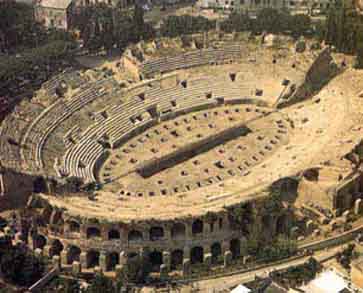 Adjacent, as it was,
to the mighty port for the Western imperial fleet at Miseno, built
by Caesar Augustus, Putèoli was a leading commercial center
and cosmopolitan city of the Roman world. Even before recent excavations
within the Rione Terra, Putèoli's importance was evident from
the ruins of the third largest amphitheater in Italy (photo, left).
It was begun under Nero and finished by Vepasian (69-79 a.d.). The
main and transverse axes measure 149 and 116 meters, respectively.
The structure could accomodate 20,000 spectators. The spaces beneath
the floor of the arena are still well-preserved and here it is possible
to see what complicated mechanisms were required to put on Roman spectacles
of the period, including the means to hoist wild beasts up to be released
into the open arena. Adjacent, as it was,
to the mighty port for the Western imperial fleet at Miseno, built
by Caesar Augustus, Putèoli was a leading commercial center
and cosmopolitan city of the Roman world. Even before recent excavations
within the Rione Terra, Putèoli's importance was evident from
the ruins of the third largest amphitheater in Italy (photo, left).
It was begun under Nero and finished by Vepasian (69-79 a.d.). The
main and transverse axes measure 149 and 116 meters, respectively.
The structure could accomodate 20,000 spectators. The spaces beneath
the floor of the arena are still well-preserved and here it is possible
to see what complicated mechanisms were required to put on Roman spectacles
of the period, including the means to hoist wild beasts up to be released
into the open arena.
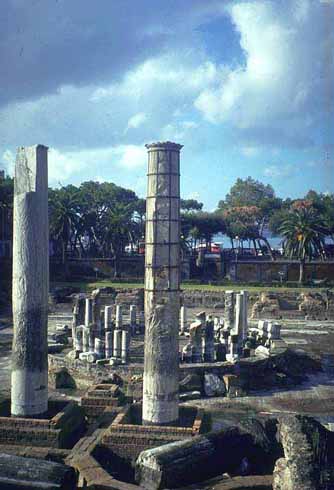 There are also remnants of baths, a vast necropolis,
and columns from the ancient Temple of Augustus (originally a temple
for the worship of Jupiter and later incorporated into the Cathedral
of San Procolo). Near the harbor, also, there stands what is still erroneously
called the "Temple of Serapis," photo, left). Apparently, it was really
a market place. Now on dry land, the bases of the columns were underwater
until the 1980s, when significant seismic activity shifted the ground
level. (This is discussed in detail in a section of the entry on geology
that you may read by clicking here.) There are also remnants of baths, a vast necropolis,
and columns from the ancient Temple of Augustus (originally a temple
for the worship of Jupiter and later incorporated into the Cathedral
of San Procolo). Near the harbor, also, there stands what is still erroneously
called the "Temple of Serapis," photo, left). Apparently, it was really
a market place. Now on dry land, the bases of the columns were underwater
until the 1980s, when significant seismic activity shifted the ground
level. (This is discussed in detail in a section of the entry on geology
that you may read by clicking here.)
The fortunes
of Putèoli declined, of course, with those of the Roman Empire.
Before the arrival of the Normans at
the turn of the millennium and the subsequent foundation of the Kingdom
of Naples, Pozzuoli was part of the little known Duchy of Naples. Its
physical fortunes eroded further over the centuries: shifting
coastlines and constant earth tremors care nothing for the hard times
they may be preparing for future archaeologists. Severe seismic activity
had so weakened the ancient buildings of the Rione Terra that
the area was almost entirely evacuated in 1970.
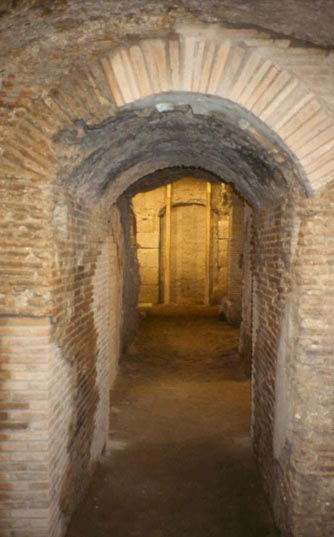 The goal of present excavations (photo,
right) is to unearth the Roman city of Putèoli, including, of
course, the main street, the decumanus maximus, and the area
around the remnant columns of the Temple of Augustus. The digs are snaking
their way back from the entrance of the exhibit through a honeycomb
of Roman ruins, only a small portion of which are, as yet, part of the
display. Although no new physical bits of Decaearchia have been found,
plenty of Putèoli has. Fragments, for example, in a totally burned-out
section near ground level have been dated to the first century a.d.;
archaeologists speculate that a disastrous fire may have been caused
by the very seismic upheaval that presaged the eruption of Vesuvius
that buried Pompeii. The goal of present excavations (photo,
right) is to unearth the Roman city of Putèoli, including, of
course, the main street, the decumanus maximus, and the area
around the remnant columns of the Temple of Augustus. The digs are snaking
their way back from the entrance of the exhibit through a honeycomb
of Roman ruins, only a small portion of which are, as yet, part of the
display. Although no new physical bits of Decaearchia have been found,
plenty of Putèoli has. Fragments, for example, in a totally burned-out
section near ground level have been dated to the first century a.d.;
archaeologists speculate that a disastrous fire may have been caused
by the very seismic upheaval that presaged the eruption of Vesuvius
that buried Pompeii.
Recent
exhibits have been in the Palazzo di Fraja, in a section of the
building that once actually incorporated a Roman taberna, a shop,
into its own structure, thus hiding it for centuries. It has been partially
cleared and restored and is one of two such tabernae uncovered
since the present excavations began. The taberna is situated
near what is now believed to be the intersection of the main cross-roads
of the old center of Roman Putèoli. The exhibit displays approximately
200 items, ranging from ceramic items to statuary.
The Rione
Terra of Pozzuoli looks somewhat like a ghost town these days, due
to the evacuation and, now, the burrowing and scraping away going on.
Yet, this inconvenience to modern residents is a blessing for archaeologists,
since they are now free to probe in and under Strabo's "fortress raised
on a cliff" in their attempts to peel away the centuries.
Pergolesi,
Giovanni Battista (1710-36)
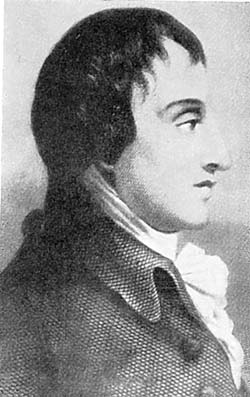 I
have it on good authority from an enthusiastic student at the Naples
Conservatory that the library in that institution is now totally
on-line, properly catalogued and up to date. It is no longer the case,
he assures me, "that there are shoe boxes in the basement with undiscovered
manuscripts of Pergolesi". I
have it on good authority from an enthusiastic student at the Naples
Conservatory that the library in that institution is now totally
on-line, properly catalogued and up to date. It is no longer the case,
he assures me, "that there are shoe boxes in the basement with undiscovered
manuscripts of Pergolesi". "Not that
there ever were," he adds.
I certainly
hope not. Pergolesi is in the forefront of important European musicians
of the early 1700s, and his influence on the development of subsequent
musical form in that century is far beyond what one might have expected
from a scant 26 years of life. He was born in Jesi, a small town not
far from Ancona in central Italy. He received early musical training
at home and then was sent to the Conservatorio dei Poveri di Gesù
Cristo in Naples, one of the four such institutions in the city
before they were consolidated into a single conservatory early in the
19th century. His teachers at the conservatory wrote of his great skill,
particularly as a violinist.
History
remembers Pergolesi largely for his contribution to what would become
the most popular form of entertainment in 18th century Europe, the opera
buffa -- the comic opera. His first
effort was Lo frate ’nnamorato (“The Enamoured
Monk”), performed at the Teatro dei Fiorentini in Naples on September
27, 1732. It was successful and is one of the few such works from
that period still performed. It was not, however, the one that "started
the ball rolling," so to speak. That honor goes to La serva padrona
(“The Maid Mistress”), composed as an intermezzo
within a larger work of his, Il prigioniero superbo (“The—[here,
superbo means “haughty,” “arrogant”]—Prisioner”),
performed for the first time in September 1733. La serva padrona
was quickly picked up in the repertoire of touring companies, and it
was one such performance in 1752 in Paris that drew the praise of Rousseau
and set off the so-called "War of the Buffoons," pitting the supporters
of traditional French opera against those of the newer opera buffa.
By general consensus, the opera buffa came out on top and defined "musical
comedy" as a discipline worthy of serious musical consideration—as
Mozart and Rossini would later confirm.
Pergolesi
wrote sacred music extensively; his Stabat Mater is still
performed, and, indeed, even crops up unexpectedly as background music
in film scores (In 2001, Space Odyssey, the large space ship
creeps slowly towards Jupiter accompanied by the delicate opening three-voice
soprano pyramid of the Stabat Mater.) Pergolesi was in Naples
when the Bourbon prince, Charles III,
moved in to reestablish the Kingdom of Naples as an independent state
after a few decades as an Austrian vice-realm, and Pergolesi's music
was among that chosen to celebrate the event at various masses held
throughout the city. He spent the last few months of his life in a Franciscan
monastery in Pozzuoli and died there of tuberculosis in 1736. Today,
a plaque on the church commemorates him.
Young,
Lamont (1); urbanology (6)
Lamont
Young and Utopian Naples
An
interesting tribute to the visionary, Lamont Young: a mural of his
1883 plan for an urban rail line for Naples adorns the walls of
a modern metro station.
|
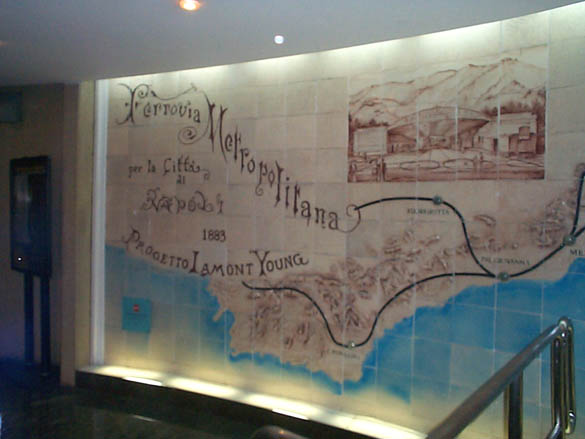 Imagine
yourself in a gondola, gliding along a delicate waterway, now and again
passing beneath a quaint wooden bridge. Trees line and shade the footpaths
on either side of the canal, and gentlemen and gentleladies are out
strolling along the banks. Gracious villas are set back from the water's
edge, and the faint melodies of late summer are in the air. Your spirit
quickens a bit as the narrow waterway makes a final gentle bend and
opens onto the majestic Grand Canal, lined by stately façades
and crossed by picturesque bridges as it carries pleasure craft out—to
the Bay of Naples! Imagine
yourself in a gondola, gliding along a delicate waterway, now and again
passing beneath a quaint wooden bridge. Trees line and shade the footpaths
on either side of the canal, and gentlemen and gentleladies are out
strolling along the banks. Gracious villas are set back from the water's
edge, and the faint melodies of late summer are in the air. Your spirit
quickens a bit as the narrow waterway makes a final gentle bend and
opens onto the majestic Grand Canal, lined by stately façades
and crossed by picturesque bridges as it carries pleasure craft out—to
the Bay of Naples!
Grand Canal?
Bay of Naples? But, surely, we are in Venice. Not exactly. We're in
the Venice Quarter of Naples, part of an unfulfilled utopian scheme
to change the city in the years before the turn of the century.
Change
is nothing new to Naples. Like medieval manuscripts written upon and
erased over and over again, there has been new upon old in this city
for a very long time. From the earliest Greeks to the present
day, different civilizations have come and gone in the Bay of
Naples and each has left its mark; the city, with a life of its
own, has outlasted the single cultures that have formed her.
It is still
possible, for example, to find in Naples the intricacy of a medieval
town, traversable only on foot and only by one who truly knows the way.
The curved streets still conceal the secrecy and surprise of the middle
ages, when you would turn a corner and find the small market or church
hidden away. Moving forward in time a bit, you then find the imposition
of Baroque order upon medieval clutter. When King Ferrante of Naples in 1475 characterized narrow
streets as a danger to the state, he was but giving political voice
to the new Baroque aesthetic of the straight and wide avenue, the open
square and the imposing façade.
The Naples
that we see today, then, has very visible traces of a long history,
but the shape the city has taken in this century is largely the result
of things done or left undone in the latter half of the nineteenth century.
Following the unification of Italy,
Naples lost its role as a capital, and was faced with deteriorating
social and hygienic conditions. Class differences and the inability
of the city to plan and execute long-term urban goals put Naples behind
other Italian cities in preparing for the new century.
This
is one of 2 or 3 such unusual "Victorian" buildings in Naples, all
built by the English- Neapolitan archictect, Lamont Young. This
particular one is on the Corso Vittorio Emanuele.
|
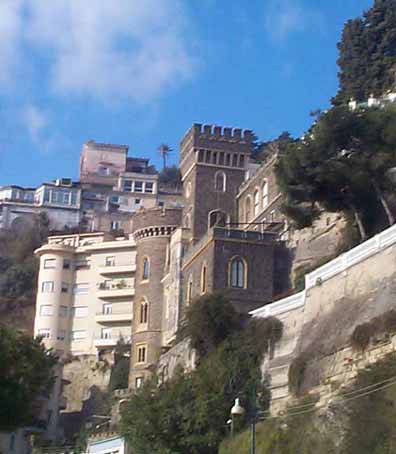 Enter
upon this scene in the 1870s a Neapolitan born of English parents, Lamont
Young, one of the most fascinating characters in the history of utopian
urban planning. His plan, approved by the Naples City Council
in the early 1880s, had it come to fruition, might have made the peaceful
vignette of the opening paragraph reality instead of fantasy. Enter
upon this scene in the 1870s a Neapolitan born of English parents, Lamont
Young, one of the most fascinating characters in the history of utopian
urban planning. His plan, approved by the Naples City Council
in the early 1880s, had it come to fruition, might have made the peaceful
vignette of the opening paragraph reality instead of fantasy.
"Utopian"
has come to mean "impractical," but Young was quick to insist that his
ideas for the Naples of the future were workable and economically beneficial.
The key to Young's ideas on how to deal with the problems of urban
sprawl —already evident in the Naples of the 1870s— was
good mass transportation. A number of factors convinced Young
that underground transit was the solution. For one, building new
streets was difficult due to the layout of the city between
the sea and hills. Young foresaw chaos if all traffic in a city such
as Naples, with the same surface area as London and Paris, but twice
their populations, stayed above ground. He rejected the piecemeal
urban expansion of the city and the gutting of the historic center
as a solution to the problem, since it involved impractical large-scale
removal and relocation of the inhabitants. Instead, he favoured
a gradual and planned expansion away from the center—a "suburbanization"—by
means of a metropolitana, an underground train system, which
he would design and build.
The
Metropolitana
In the
late 1870s the City Council called for proposals for a transit system.
Young's plan involved (1) steam locomotives for tunnels to be
built beneath Montesanto and Posillipo; (2) Tramways—horsedrawn
cars on tracks, and (3) the Omnibus—horsedrawn cars, but
no tracks. The plan was rejected because it was too complicated.
In December
of 1880 he presented a new plan to the City Council, complete with approximately
one hundred tables and drawings. It detailed an extensive metro
network of twelve stations along a 22 kilometer route from Fuorigrotta
to the main train station, replete with passenger lifts to Vomero connecting
to narrow gauge railways to the outskirts. The Metro rail gauge would
be compatible with the state trains already in use, thus allowing the
state railway to use the Metro tracks.
Although
the plan was generally treated kindly in the press, it was eventually
turned down, and it is not exactly clear why. Perhaps it was due to
general fear of structures collapsing from construction along the planned
route. To meet this fear, Young modified his plan in 1883. Changes consisted
largely in elevating some underground sections from beneath populated
areas to run on the surface or overhead, leaving underground only
those sections that passed necessarily though hills within the city.
The plan entailed the creation of two new quarters of the city: one,
a Venice Quarter, along the coast of Posillipo, and, two, a tourist
and residential quarter in Campi Flegrei, west of the city, beyond the
Posillipo hill.
This new
plan was published in 1883 and was entitled "The Metropolitana and Campi
Flegrei," and it stressed safety. The underground stretches were through
the tufa, deep in the hills, while the surface portions were away
from residences or elevated to run high above roadways. The line
started west of Naples in Bagnoli and covered the entire center of the
city as well as the suburbs. It included the difficult hill areas of
Fuorigrotta, Posillipo, Mergellina and Vomero, as well as the densely
populated parts of the inner city and the central train station.
From the station, elevated sections ran along via Marina and
Riviera di Chiaia and back to Mergellina and Bagnoli. A separate
line branched in from the seaside to handle the most densely populated
downtown areas.
Ingeniously,
there were two separate Vomero stations, with passengers rising
by lift 160 metres from the bottom station to the top one, where they
could connect to railway lines for outlying areas. Young's 1886
revision to the plan also included a "hill line" running from Capodicchino
through Vomero and on to Posillipo. It showed considerable foresight,
anticipating the hill communities that later were to spring up
in those areas.
The
Venice Quarter
The need
to dispose of the material excavated along the Metro route led Young
to propose using the material as fill along the picturesque Posillipo
coast for a giant reclamation project. Literally, Young's plan was to
have the land-fill cut by navigable canals of sea-water, thus creating
artificial islands interconnected by bridges. Buildings and gardens
on the islands would "give to our quarter the appearance of a tiny Venice,"
a 1500-meter extension up the Posillipo coast of the newly
completed via Caracciolo, an avenue running along
the sea from the historic section of Santa Lucia up to Mergellina along
the old Royal Gardens of the Bourbon
dynasty.
For those
who saw his idea as too romantic, he claimed it was based on solid economics:
He thought the combination of a mini-Venice with the natural beauty
of the Bay of Naples would put Naples virtually at the top of the world
property market. The whole Venice area covered over four square
kilometres; half for canals and streets and half for land to build on,
much of which, however, would be gardens, keeping a favourable
ratio of open spaces to buildings. The waste disposal system was well
thought out, and the whole quarter rose 2,50 meters above the sea to
keep dampness out of the dwellings.
The main
street, an extension of via Caracciolo, passed over the canals
by a series of bridges. One long canal, Partenope, was crossed
by seven secondary canals, all with outlets to the sea and to each other.
The general effect was of smaller canals leading off of three larger
ones which formed a letter "Y", the stem of which was the Grand Canal.
Within the network was a large circular canal hub, the Venice-end
of the canal-tunnel to be dug through Posillipo to Campi Flegrei. (Difficult,
but not impossible—the Romans built a similar tunnel two thousand
years ago, which may still be visited today.) Young's canal would be
almost two kilometers long, and he was convinced that it would eventually
prove to be the main connector between the west side of Naples and the
new quarter in Campi Flegrei. Young's illustrations for the project
are typically Victorian with their neo-Gothic buildings, bridges and
towers.
Campi
Flegrei
Young's
plans re-created Campi Flegrei, the area
north of Naples beyond the Posillipo hill. The area focused around
two central points and included the "Crystal Palace" and a number
of hotels and beach establishments, private villas, exposition halls,
and thermal bath facilities. Fuori Grotta, the area farthest
from the sea, housed the metropolitana station, residences and the Crystal
Palace. Other sections sloped gently down towards the sea and were given
over to villas and gardens; the seaside area was a beach resort and
included a zoo, shops and hotels. There were also two artificial
lakes and a series of canals which joined the main one leading beneath
Posillipo to the Venice Quarter.
Young emphasized
greenery and trees. The general impression was of a vast park with an
occasional structure. Numerous parks and gardens allowed, according
to Young, ample space for gymnastics and games. There was an English
garden and an Italian one; small game abounded and Swiss chalets dotted
the small hill known as S. Teresa. The whole area had a network
of wood or metal bridges over the canals. Also, a narrow-gauge
electric railway linked up to the metropolitana.
The most
interesting structure in the area was the Crystal Palace. It was on
the shores of the Small Lake in Fuorigrotta and was named for
the Crystal Palace of the Universal Exposition in London in 1851. It
would be a showpiece for Neapolitan Art, theater, exhibitions and concerts.
Young, however, viewed the structure also as a means of educating the
people. It was an all-purpose cultural establishment, so that
"those who cannot travel or who are not widely read…may have a
temple in which science can speak to the imagination…where they
may learn how the human spirit has developed."
Via
Marina (the road now running along the main port of Naples) and
the new via Caracciolo meant, for all practical purposes, that
there were no longer any real beaches left in the city, itself. Young
saw the bathing resort in Bagnoli as a way to give Neapolitans back
something they had lost. He designed a bathing pier for Bagnoli:
it formed three sides of a rectangle; the first leg ran 400 meters along
the beach in Bagnoli opposite the tiny island of Nisida and provided
dressing rooms. The other two sides were long double–decker piers
in the water, letting you stroll along in the shade or take a dip, as
you desired. The facility was to accommodate 20,000 persons a day.
Such a
plan necessarily called for a hotel to go along with it. After all,
the resort was as much for tourists who would stay a while as it was
for day trippers from Naples. Young wanted a hotel that combined the
majesty of the hotels at English seaside resorts with the comfort of
the resort hotels in America. It was to be on the shores of the Greater
Lake. The most striking feature was the 50–meter high metal and
glass dome, visible form the entire area. Inside, there were restaurants,
thermal baths and a magnificent Winter Garden, tropical plants and all.
Adjacent to the hotel and forming a symmetrical whole with it were
two thermal cure baths. Young emphasized that although one of the facilities
might serve the well-to-do clients in the Hotel Termine, he intended
the second one for everyone, "for all social classes". Young saw Naples
as becoming another London or Paris. "I see the city of my dreams, Naples,
fifty years from now, risen majestic and enchanted in the most beautiful
area in the world."
Young's
"fifty years from now" never worked out. The population explosion and
the overwhelming influence of the private automobile (entirely unpredicted
in the last century, even by those who foresaw flying machines!) have
done much to confound the plans of visionaries, Young's included. Aside
from those things, however, how practical was his idea? His critics
say he showed a typically English lack of interest in the bonds that
Neapolitans, historically, seem to have to have to the center of their
city. He would, they say, have created a city with quarters for
the rich, virtually ignoring the needs of the poor. He ignored the possibility
of industry in the area. He made no plans for large numbers of working
class, rather seeming to think that those who worked for a living would
remain a fixed number and have to do only with managing tourism. His
plans for a Venice Quarter and a leisure resort in Campi Flegrei amounted,
they say, to little more than an anachronistic Victorian fantasy, instead
of a realistic attempt to deal with the coming century.
Much of
the criticism of the Venice idea was that it was too "poetic". Young,
however, was always quick to point out the economic and practical advantages
of his plan. He was convinced that his idea to decentralize the city
by rapid transit was a good practical idea. Young was not optimistic
about getting his plans approved; he felt there were vested interests
working against him. In spite of his pessimism, he was given the go-ahead
by the city council, contingent upon his ability to raise the money.
And here the story ends. The building time was set for five years. Young
was given six months to set up a private consortium to finance the project
without state intervention. He had apparently been relying on English
banking interests for support. The six months ran out without the necessary
financial support and the city council granted an extension. It, too,
ran out.
Actually,
there were two plans for rebuilding Naples. Young's plan lost out to
the eventual winner, the risanamento,
a draconian plan that gutted much of the city. The decision to choose
that plan over Young's was made in the wake of the great cholera epidemic of 1884, a crisis that cried out
for solution. The risanamento was more of a surgical solution
than Young's, and who knows what role such metaphors play in making
difficult choices such as how to rebuild a city? (It is also possible
that there really were vested interests working against Young
and for the risanamento.)
Young's
plans may well have been an anachronism, in the sense that they were
too forward looking. Today, Naples is still in the midst of building
a satisfactory underground railway line. Ironically, on the wall of
one the stations of the new line there is a beautiful ceramic map displaying
Young's original plans for a Naples Metro from 120 years ago!) The
suburbs of Bagnoli and Campi Flegrei suffered the industrial blight
of a steel mill and a cement factory for almost a century. Both of those
enterprises have been abandoned and the area is now priming for an episode
of non-industrial urban renewal on its own, based on the spectacular
natural beauty of the bay. These plans include luring the next
America's Cup regatta to the waters of Bagnoli. Meanwhile, the nearby
tourist resorts of Sorrento and Capri thrive on the leisure time of
tourists, a recent phenomenon that Young's critics could not have foreseen
when they labelled his vision of a new Naples an anachronistic Victorian
fantasy.
Carminiello
ai Mannesi
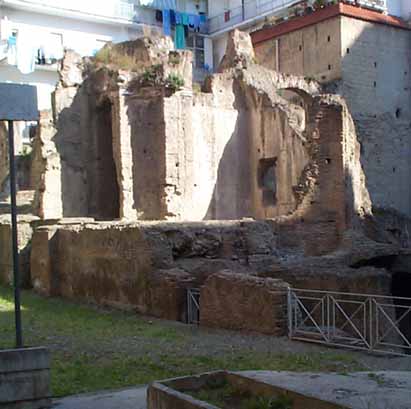 I accompany people around Naples from time to time and
am often subjected to the ultimate hard question: "Gee, what's that?"
My standard answer is: "Oh, that's a dextral embrasure flanked by a
counterscarp dripstone thing. They say it was built right before the
Mopedoid invasions, but they have been wrong before". I accompany people around Naples from time to time and
am often subjected to the ultimate hard question: "Gee, what's that?"
My standard answer is: "Oh, that's a dextral embrasure flanked by a
counterscarp dripstone thing. They say it was built right before the
Mopedoid invasions, but they have been wrong before".
Naples
has a Gee-What's-That? on every street, and I found another one the
other day, hidden behind the old monastery that the Orientale University
of Naples now uses for classes, one block south of the Duomo, the cathedral.
It is the
complex —and just a fraction of it sticks up above ground—of
the Roman baths Carminiello ai Mannesi, (unmarked, but near number
30 on the map of the historic center of the
city). The original complex covered about 700 sq. meters. Archaeological
evidence suggests that the baths were terraced down towards the sea.
The complex—or part of it—stood on the site of an earlier
structure, a temple from the 5th century b.c., centuries before the
Romans took over the area. The Romans built up the area in the early
imperial age under Augustus and, again, following damage caused by the
earthquake of 62 a.d. and the infamous Pompeii eruption of 79 a.d. The
baths were abandoned in the 5th century a.d. at about the time of the
fall of the western Roman Empire. There was subsequently a brief period
when the site was used by a cult dedicated to Mithras, the Persian god
of light, whose worship had been imported to Rome; the cult spread throughout
the empire to become the greatest rival of Christianity. Eventually,
however, the area was totally abandoned; no doubt the area was affected
by the great mudslide that covered much of the city just to the west
in the 600s.
A Christian
house of worship arose in the Middle Ages on the site and was part of
a greater church called Santa Maria del Carmine ai Mannesi. "Carminiello"
is a diminutive and the "mannesi" part of the name refers to the occupation
of those who lived in the area; they worked with wood and made and repaired
carts. In Neapolitan toponymy, the name of the church is used to refer
to the much older Roman structure, in the same way as, say, the "ruins
of San Lorenzo" refer to the old Roman market excavated beneath
the medieval church of San Lorenzo.
Archaeological
interest in the area was aroused following arial bombardments in WW2
when destruction of buildings on the surface lay bare some of the 2,000–year–old
ruins. Serious work and catalogueing of the site had to wait until 1993.
Like much of what lies beneath modern Naples (virtually all of ancient
Naples), the site will never be totally excavated. Although the site
now has a fence around it and is marked as an object of historical interest,
I have never seen it open.
Di
Giacomo, Salvatore (1860-1934)
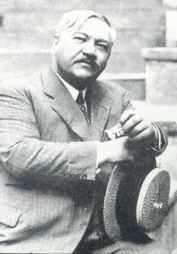 I am not sure how you come to
an appreciation of dialect poetry in a foreign language. Even dialects
of your own language are hard enough. If you are from Paris, you
are not necessarily familiar with Provençal, the language of
southern France, the brilliant language of the troubadours in the Middle
Ages. Or in English, unless you are actually from Scotland or have a
particular interest in Scots English, you probably know less than you
should about Robert Burns. I am not sure how you come to
an appreciation of dialect poetry in a foreign language. Even dialects
of your own language are hard enough. If you are from Paris, you
are not necessarily familiar with Provençal, the language of
southern France, the brilliant language of the troubadours in the Middle
Ages. Or in English, unless you are actually from Scotland or have a
particular interest in Scots English, you probably know less than you
should about Robert Burns.
I
am using the term "dialect" in its linguistic sense: a variety of language,
in no sense inferior or less than the standard language -- simply the
non-standard variety of an official language, one spoken by a relatively
small group of people in a limited area—thus,
Provençal in France, Scots in Britain, and --the case in point--
Neapolitan in Italy. [For another item on the Neapolitan dialect, click here.]
That
positive definition of "dialect" is not necessarily appreciated even
by the people who speak one. There is throughout the world a feeling
among many speakers of such dialects that there is something uneducated
about the way they speak, something wrong with not conforming to a national
standard. It is, however, a matter of fact that many dialects
have long histories of song, poetry and theater and have simply lost
the social, political (and, in some cases, military) struggle over who
comes out on top in the "official language" contest. (There is, very
recently, a backlash against standard, homogenized culture; witness
the worldwide attention now being paid to the plight of so-called "endangered
languages". This is a welcome trend.)
In
the case of Italian, if you have studied it formally, you have learned
the national language of Italy, the recognized standard based on the
medieval Tuscan vernacular Latin of Dante, the language of The Divine
Comedy, the progenitor of all modern Italian literature. You can
travel the length of Italy—and you can even live in the country successfully—and communicate quite well with most people, but you are still
at a disadvantage when it comes to appreciating local varieties of language,
the dialects that some 60% of Italians still speak at home. And, of
course, you will not be able to enjoy the considerable body of dialect
literature, theater and song.
In
that respect, the dialect of Naples has a long written history. It was
the written court language of the Aragonese dynasty in Naples in the
1400s. From that period, Neapolitan gave us the works of Jacopo Sannazaro,
whose verses in vernacular were influential in providing models for
the formation of modern Italian, itself. Neapolitan was the language
of The Tale of Tales (Lo Cunto de
li Cunti) from the early 1600s, the oldest and most celebrated collection
of folk tales, including Zezolla, the original tale of Cinderella.
In the 18th-century, Neapolitan was the language of the Comic
Opera, a forerunner of modern musical comedy. And, of course, the
entire world knows the Neapolitan Song, though perhaps misidentifies
it as "Italian" music. In the 20th-century, the great Neapolitan playwright,
Eduardo de Filippo, is perhaps the Neapolitan best
known abroad for his work. Again, the plays of Eduardo are usually "Italianized"
when they are produced in other parts of Italy, simply so an audience
in, say, Milan can understand them. "Italianized," here, means keeping
the general Neapolitan accent, cadences, some vocabulary, but changing
the died-in-the-wool Neapolitan vocabulary to a more widely understood
standard. Neapolitan has one advantage that other Italian dialects do
not: Eduardo is so well known, the Neapolitan Song is so well known,
Neapolitan comics such as Totò and, more recently, Massimo
Troisi, are so well known, that all Italians will tell you that
they understand at least some Neapolitan.
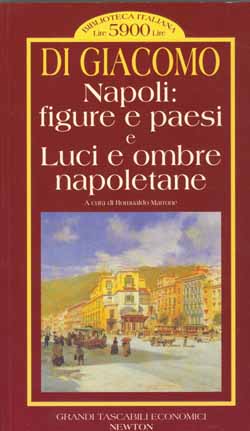 Salvatore
di Giacomo is best known among Neapolitans as the lyricist for a number
of Neapolitan songs, most popular of which is Marechiaro. Among
poetry lovers, however, and literary critics, he is one of those responsible
for renewing Neapolitan dialect poetry at the turn of the 19th/20th
century in the face of the onslaught of standardized Italian, the language
of newly united Italy. Again, dialect is not to be seen necessarily
as the language of rough realism, the language of the lower classes
and the uneducated. (It may be that, too; in English, for example, that
angle is caricatured in such works as Shaw's Pygmalion, where
the whole play is given over to remaking Liza Doolittle by remaking
the way she speaks.) The language of Salvatore Di Giacomo is not the
everyday language of his contemporaries. It is not the language of,
say, the Neapolitan working class of the late 1800s. His Neapolitan
has a distinct 17th-century flavor to it, archaisms that recall the
golden age of Neapolitan culture, the period between 1750-1800, when
Neapolitan was the language of the best-loved form of musical entertainment
in Italy, the Neapolitan Comic Opera, and was even the language of the
Bourbon court of Naples, itself. His language has, thus, somewhat
the feeling of nostalgia to it. Turns of centuries seem to bring that
out in poets. Salvatore
di Giacomo is best known among Neapolitans as the lyricist for a number
of Neapolitan songs, most popular of which is Marechiaro. Among
poetry lovers, however, and literary critics, he is one of those responsible
for renewing Neapolitan dialect poetry at the turn of the 19th/20th
century in the face of the onslaught of standardized Italian, the language
of newly united Italy. Again, dialect is not to be seen necessarily
as the language of rough realism, the language of the lower classes
and the uneducated. (It may be that, too; in English, for example, that
angle is caricatured in such works as Shaw's Pygmalion, where
the whole play is given over to remaking Liza Doolittle by remaking
the way she speaks.) The language of Salvatore Di Giacomo is not the
everyday language of his contemporaries. It is not the language of,
say, the Neapolitan working class of the late 1800s. His Neapolitan
has a distinct 17th-century flavor to it, archaisms that recall the
golden age of Neapolitan culture, the period between 1750-1800, when
Neapolitan was the language of the best-loved form of musical entertainment
in Italy, the Neapolitan Comic Opera, and was even the language of the
Bourbon court of Naples, itself. His language has, thus, somewhat
the feeling of nostalgia to it. Turns of centuries seem to bring that
out in poets.
Di Giacomo
was born in Naples in 1860. His father was a doctor and his mother a
musician. He studied medicine briefly, largely to satisfy his father's
wishes, but then gave it up for the life of a poet. He founded a literary
journal, Il Fantasio, in 1880, and, like many young writers,
had a varied apprenticeship: he worked in a printshop for a while;
he was a journalist, publishing some of his early verse in the Neapolitan
daily, il Mattino; he showed up at poetry readings and song festivals
to read his material. He even wrote a series of youthful stories à
la Hoffman and Poe set in an imaginary German town inhabited by
sinister students and mad doctors. Not unsurprisingly, he had a lifelong
love of libraries as well as literary and historical research, founding,
in the course of his career, the Lucchese section of the National library
in Naples and holding the position of assistant librarian at the library
of the Naples Music Conservatory. He was, with Benedetto
Croce, one of the founders of the literary journal, Napoli Nobilissima.
He received a critical boost in 1903 when Croce published a defense
of dialect poetry. Di Giacomo published no anthology of his collected
poems until 1907 when he was 47 years old. He died in 1934.
His plays,
such as A San Francesco and Assunta Spina, are bitter
stories about turn-of-the-century life in the Naples of the Risanamento
(the massive and decades-long urban renewal of the city that displaced tens of thousands
of persons), workers whose health is ruined by their labors, prostitution,
betrayal, prison, crime, etc. --all this, perhaps, to show that he wasn't
just a songwriter. He did write, as noted, above, easily and abundantly
for the famous Neapolitan song festival of Piedigrotta,
a fact that still leads some critics to dismiss him as a lightweight.
Financially, he did all right from the song-writing business, at least
for a while. Before WWI, a major German piano manufacturer, Polyphon
Musikwerke, opened and sponsored a record shop in Naples,
providing Di Giacomo with an outlet for his work. The outbreak of the
war, however, and subsequent anti-German sentiment caused the shop to
close.
Di Giacomo
was a passionate reader and reporter of history, though, again, in the
eyes of critics, not a "real" historian. He had the delightful journalistic
flair for padding the word count. Thus, a very informative history of
Neapolitan theaters, including, of course, San Carlo, starts with a 2,000-word letter written
by a bored opera-goer, a woman present in 1737 at opening night of the
first-ever opera put on in the new theater. She wrote the letter in
the course of the performance! Di Giacomo delighted in pointing things
out that not everyone knew about very familiar places in Naples:
that little church, Santa Maria della Graziella, down there on the side
street that you pass every day, was the site of the original opera house
in Naples; or the famous grotto behind the church of Piedigrotta—is
that really the site of the goings-on recounted in the most infamous
piece of pornography in Latin literature, Petronius' Satyricon?
One gets
the feeling that Di Giacomo viewed standard language as a necessary
evil --good, even necessary, for modern commerce and politics,
but almost by definition devoid of the life that people bring to the
language they speak --the joy, sadness, lust, music -- the vernacular
turn of phrase that exists only at a particular place in a particular
time for a particular people. He closed his own essay on Neapolitan
dialect poetry, written in 1900, with this passionate quote from the
great vernacularizer, Dante: "With the gifts God gives us from Heaven,
we shall try to renew the language of the common people."
Cuma
(1)
Keeping
a Sibyl Tongue in Your Head
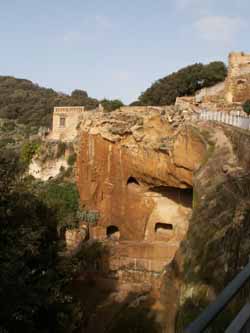 Time
has not been kind to Cuma. In Rome, for example, it is no problem at
all to wander among Imperial relics and be awed by antiquity. Indeed,
even in Naples, itself, if you criss-cross the historic center of town,
you are still very much in physical contact with downtown Neapolis of
400 b.c. Cuma, however, is different. Today, it is an "archaeological
park," where you get the impression that, well, here is where the Greeks
maybe built a temple or something. There is little to remind the average
visitor that Cuma was one of the truly important Greek city-states of
the ancient world, just like its more famous cousin, Athens. Time
has not been kind to Cuma. In Rome, for example, it is no problem at
all to wander among Imperial relics and be awed by antiquity. Indeed,
even in Naples, itself, if you criss-cross the historic center of town,
you are still very much in physical contact with downtown Neapolis of
400 b.c. Cuma, however, is different. Today, it is an "archaeological
park," where you get the impression that, well, here is where the Greeks
maybe built a temple or something. There is little to remind the average
visitor that Cuma was one of the truly important Greek city-states of
the ancient world, just like its more famous cousin, Athens.
Cuma plays
a large role in many of the myths handed down to us as part of our classical
heritage: Ulysses and Aeneas both landed here, the Cyclopes roamed here,
and here was the entrance to Hades through the Averno swamp. Cuma, of course, is best known as the
abode of the sibyl, the priestess of Apollo, one of many in the Greek
world, and the most famous. In the fifth century, BC, she is said to
have offered to sell the Etruscan king of Rome, Tarquin, nine books
of prophecy. Twice, the king refused. Each time the sibyl tossed three
of the books into a fire and doubled the price on those remaining. Tarquin
bought the last three books; they contained instructions for gaining
the favor of foreign gods. Perhaps Tarquin sensed, rightly, that his
Etruscans were about to need all the help they could get in the face
of the impending revolt of their Roman subjects. The Sibylline books
were used to invoke divine help in 431 during an epidemic, and thus
did the foreign god, Apollo, make his way into the Roman pantheon, the
first of many Greek deities to do so.
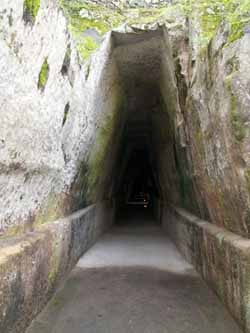 Legend
has it that the sibyl was a priestess who forgot to mention eternal
youth when she bargained with Apollo for eternal life, thus winding
up an old hag dispensing prophecy from within her many-chambered grotto
(photo). If you choose not to believe that version, you are free to
hold that popular imagination of the day synthesized into a single person
what was really a long succession of priestesses of the cult of Apollo.
This figure of the Sibyl of Cuma later found great favor among the Romans.
In the Aeneid, Virgil uses the
sibyl to introduce his hero to the netherworld, and, indeed, we owe
to Virgil our only description of the grotto of the sibyl: Legend
has it that the sibyl was a priestess who forgot to mention eternal
youth when she bargained with Apollo for eternal life, thus winding
up an old hag dispensing prophecy from within her many-chambered grotto
(photo). If you choose not to believe that version, you are free to
hold that popular imagination of the day synthesized into a single person
what was really a long succession of priestesses of the cult of Apollo.
This figure of the Sibyl of Cuma later found great favor among the Romans.
In the Aeneid, Virgil uses the
sibyl to introduce his hero to the netherworld, and, indeed, we owe
to Virgil our only description of the grotto of the sibyl:
But
good Aeneas
Makes for the hill-top, where aloft sits throned
Apollo, and a cavern vast, the far
Lone haunt of the dread Sibyl, into whom
The Delian bard his mighty mind and soul
Breathes, and unlocks the future
The Mighty face of the Euboean rock
Scooped into a cavern, whither lead
A hundred wide ways, and a hundred gates;
Aye, and therefrom as many voices rush,
The answers of the Sibyl. |
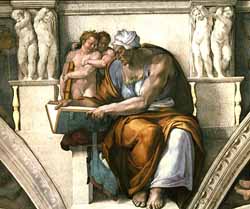 Fascination
for the figure of the sibyl continued even into the Renaissance,
where she puts in an appearance in Michelangelo's paintings in the Sistine
Chapel (photo). Fascination
for the figure of the sibyl continued even into the Renaissance,
where she puts in an appearance in Michelangelo's paintings in the Sistine
Chapel (photo).
The Cumans
came from from Eubea in Greece to settle on the Italian mainland, although
they apparently settled first on the island of Ischia before moving
across to the mainland to displace an Italic people known as the Opici.
This happened sometime after the ninth century b.c., although there
are questions about the precise date. In any event, the Cumans built
themselves into a formidable power in this part of the Mediterranean,
contending over the course of three centuries with other powers such
as the Etruscans from the north and, later, with the Samnites
from the interior.
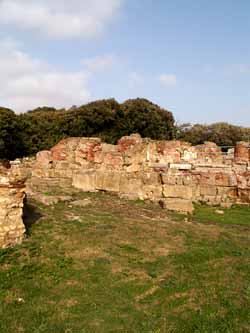 The
city-state of Cuma was at its height roughly between the years
750-500 BC, ruling much of present-day Campania. The city, itself, spread
out well beyond the simple site of the acropolis we see today into the
surrounding area of Miseno and Baia. In 680 the Cumans helped to found
modern Naples, in the sense that they moved in to displace settlers
from Rhodes, who were then forced to desert their own original town
of Parthenope and move inland to set up a new city, a neapolis—Naples.
The two populations eventually mixed, as did the old and new cities.
("Parthenopean" still remains a common synonym for "Neapolitan" in local
usage.) The Cumans also reached out further south to found Zancle, modern-day
Messina. At its height, Cuma was a bulwark against Etruscan expansion
from the north and played a part in the defeat of the Etruscans by a
fleet from Sicily in the waters off of Cuma, hastening the demise of
Etruria. Then, in 420, the Cumans, themselves were annexed by another
great early Italic power, the Samnites, fierce warriors from the rugged
territory near Benevento, who later battled the Romans for two centuries
for hegemony in southern Italy—a battle the Samnites ultimately
lost. The
city-state of Cuma was at its height roughly between the years
750-500 BC, ruling much of present-day Campania. The city, itself, spread
out well beyond the simple site of the acropolis we see today into the
surrounding area of Miseno and Baia. In 680 the Cumans helped to found
modern Naples, in the sense that they moved in to displace settlers
from Rhodes, who were then forced to desert their own original town
of Parthenope and move inland to set up a new city, a neapolis—Naples.
The two populations eventually mixed, as did the old and new cities.
("Parthenopean" still remains a common synonym for "Neapolitan" in local
usage.) The Cumans also reached out further south to found Zancle, modern-day
Messina. At its height, Cuma was a bulwark against Etruscan expansion
from the north and played a part in the defeat of the Etruscans by a
fleet from Sicily in the waters off of Cuma, hastening the demise of
Etruria. Then, in 420, the Cumans, themselves were annexed by another
great early Italic power, the Samnites, fierce warriors from the rugged
territory near Benevento, who later battled the Romans for two centuries
for hegemony in southern Italy—a battle the Samnites ultimately
lost.
When the
Romans annexed Cuma, it flourished once again, this time as a sort of
an early version of the Riviera. Here is where the "beautiful people"
of the Empire rubbed elbows. Cicero, Lucullus, Julius Caesar, Pliny,
et alii, built villas and took the waters in the famous thermal
baths of the Flegrean fields. Further growth took place when Caesar
Augustus turned the entire area of Miseno
into a mighty port for the Western imperial fleet.
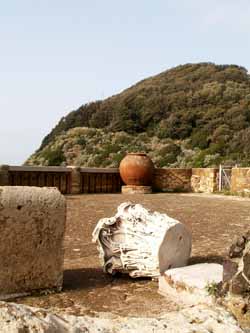 After
the fall of Rome, Cuma was apparently used as a base by the invader
Goths. It then turned Greek again for a brief period under the short-lived
Byzantine reunification of Italy, subsequently falling under the dominion
of the Duchy of Benevento. It was sacked a few times during Saracen
incursions and, finally, Cuma, this first great city in Italy, was little
more than a nest for itinerant pirates when it was destroyed by Naples
in 1207. Yet, fascination with Virgil's description held sway over the
centuries. In the Middle Ages they searched for the Sibylline grotto
and even thought they had found it a few times. (Today there is still
a falsely identified "grotto of the sibyl" off of nearby Lake Averno,
and you can still find a guide to tell you with a straight face that
it's the real thing!) After
the fall of Rome, Cuma was apparently used as a base by the invader
Goths. It then turned Greek again for a brief period under the short-lived
Byzantine reunification of Italy, subsequently falling under the dominion
of the Duchy of Benevento. It was sacked a few times during Saracen
incursions and, finally, Cuma, this first great city in Italy, was little
more than a nest for itinerant pirates when it was destroyed by Naples
in 1207. Yet, fascination with Virgil's description held sway over the
centuries. In the Middle Ages they searched for the Sibylline grotto
and even thought they had found it a few times. (Today there is still
a falsely identified "grotto of the sibyl" off of nearby Lake Averno,
and you can still find a guide to tell you with a straight face that
it's the real thing!)
It wasn't
until the middle of the 20th century, however, that the real
thing was brought to light, uncovered through the efforts of the great
Neapolitan archaeologist, Amedeo Maiuri. The chamber in question is
strangely trapezoidal; the oddly tapered walls are perhaps the influence
of Etruscan architecture. It is the closest thing yet found to the chamber
described by Virgil, but is it the real "real thing"? Probably,
but only one person knows for sure, and she has been silent for many
centuries.
|
